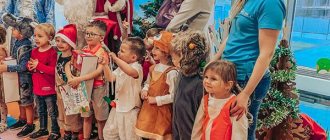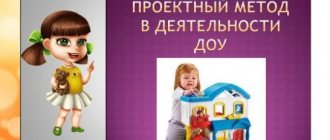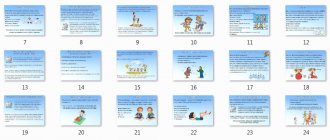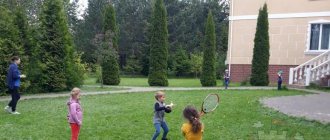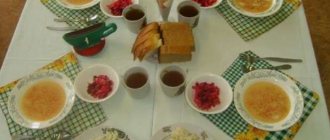What types are there?
The most common types of modeling in kindergarten:
- Object modeling is intended for depicting single objects, such as dishes, animals and people. The child, using all kinds of methods and techniques, learns to give plastic material its final form.
- Story modeling is designed to develop three-dimensional three-dimensional thinking in a child. Plot modeling is a long and labor-intensive process, because the child needs to sculpt from plasticine not one, but several three-dimensional figures, connected by a common story, idea, and performing some action in relation to each other. We can say that the baby learns to create his own plasticine fairy tale, choosing the plot he likes best. Such modeling is installed on a rigid stand on which figures sculpted from plasticine will be installed.
- Decorative modeling in kindergarten allows a child in the younger group to become familiar with and learn how to make simple figures and objects made in the style of folk applied art. So, a child who has already learned object modeling, showing imagination, diligence and turning on his imagination, will turn ordinary plasticine dishes into elegant ones, decorated with decorative patterns. Such dishes can already be used to decorate your home and give as a gift. A figurine made in folk applied style will teach your child to distinguish between styles in art and awaken interest in learning new things.
So, stage by stage, the little man from the younger group learns perseverance, develops his imagination, and fine motor skills work at full speed. The child learns to hold stacks in his hands and use them correctly when sculpting. Learns to touch and visually distinguish different materials for modeling (clay, plasticine), even non-traditional ones, such as salt dough. Receives first mathematical knowledge, such as size, shape. Recognizes the appearance and name of various geometric shapes. We can safely say that aesthetic education has begun!
MOLDING IN A PREPARATORY SCHOOL GROUP
Detsky sad.Ru >> Electronic library >> Family and children >> Children's creativity >> Features of the plastic form created by children of the preparatory group for school
The molded products of children of the preparatory group are more expressive, more interesting and varied than those of children 5 years old. This is explained by the fact that they have accumulated a larger stock of visual images. The children's hand muscles have become stronger. Speech and thought processes were further developed. During observations, 6-year-old children more fully perceive the phenomena of the surrounding reality and the shape of objects. They become better oriented in space and begin to understand how objects can be arranged in relation to each other. Changes in development lead to changes in the nature of visual activity. Children develop a desire to more accurately convey shape and proportions; they begin to be fascinated by the image of details and objects that complement the image. Children understand that the arms and legs of figures to depict steps and other actions can not only be positioned and raised, but also bent, as a result of which the sculpted figures become more expressive. In addition, they can immediately determine in what position the depicted object should be and set the main part accordingly. For example, a child immediately determines the position of a piece of clay when depicting a running hare or a sneaking fox. Compared to the older group, children increasingly use the method of pulling from a whole piece and widely use the stack, performing many operations with it. Despite the fact that the entire process of creating an image has become more creative and independent, the form, sculpted with a greater understanding of its structure, continues to remain very generalized, for example, the head is often depicted as a ball, the body as an ovoid (oval) shape. This indicates that 6-year-old children do not yet have access to a complete image of all the features of the form, and they convey only its basis, unconsciously discarding the complexities of the structure. But in order for children to be able to depict an object, even in such a generalized form to make it understandable to others, they must clearly imagine the appearance of the object with all its features.
Learning Objectives
The curriculum for children in the preparatory school group is much more complex and varied compared to the program for the senior group. Children must learn visual and muscular perception of the shape of an object, use various expressive means in modeling, and also master visual and technical techniques. Children 6 years old, as a rule, use many methods of depiction, but the main one should be the plastic method - sculpting from a whole piece. At the same time, relying on previously acquired knowledge of volumetric bodies (cone, sphere, ovoid, cylinder), children must independently determine the initial shape for sculpting objects. The teacher, developing creative initiative, gives them the opportunity to independently choose topics, means of expression and methods of depiction. All listed tasks are specified by quarter.
Completion of the program
I quarter In the first quarter, the teacher is faced with the task of teaching children to sculpt the characteristic shape of objects. To do this, at the beginning of the year they are asked to depict vegetables and fruits. If in the older group children sculpted vegetables of different shapes (cucumber and beetroot) in order to better understand their characteristics by contrast, then in the preparatory group the task became more complicated: children were asked to sculpt two homogeneous objects of different shapes, for example, one oval-shaped apple (Crimean) , and another round shape (Antonovskoye), several types of cucumbers, etc. You can use sculpted fruits or vegetables to create a common composition with your children on a plate, in a basket or in a vase. With repetition, anyone can create a small composition from their imagination from sculpted vegetables or fruits, but for this it is better to use not clay, but plasticine, the color of which will be an additional means of expression. It is necessary to teach children to create figures based on a toy or sculpture that depict an object in action: a singing rooster with its head held proudly, a kitten playing with a ball, etc. Looking at the toy, the child must understand the main direction of the form and immediately establish the main part in that the position in which the depicted object will be located. Children sculpt animals according to the idea. They must clearly imagine the nature of the shape of the main part and those features that distinguish this animal from others. For example, the difference between dogs of different breeds, a bear from a wolf, a duck from a goose, a rooster from a chicken. Modeling by representation makes it possible to freely fantasize when depicting the position of parts of a figure, action, and texture. Children can use various artistic and technical techniques (sculpting from a whole piece and in parts, conveying the texture in deep relief using stacks or by molding). Children can pass an object in any state and position, for example, a cat sits on its hind legs and leans on its front legs; The cat plays with a ball and sneaks after the mouse. When creating an image from an idea, children will be guided by general knowledge about the structure of animals and that which they received during sculpting from life. Children can convey rather subtle differences, for example, in dogs of different breeds in the length and shape of the body, in the length of the legs, in the structure of the head and muzzle. Successful depiction of objects depends on the way the parts are connected. In addition to applying one part to another, you can connect them by inserting one part into a recess on the other, having previously made notches on the end of the part that is being inserted. While depicting individual objects, children continue to learn how to place the figures in a vertical position on stands. In the first quarter, children continue to sculpt a human figure. At first these are simple figures, repeating the method of sculpting those that were sculpted in the older group. Gradually, while modeling from life (usually dolls), children clarify the shape and proportions of the human figure. The teacher, together with the children, compares the sizes of the parts and determines how many times the head fits in the entire body of the doll. Figures of people can also be sculpted using toys from Dymkovo craftsmen. They are more complex in their proportions, primarily because they mainly depict an adult whose head fits into his body 7-8 times. In the older group, children sculpted these figures, but in the preparatory group, the requirements for depicting shapes and proportions increase. The modeling method used by Dymkovo craftswomen is introduced: the head and jacket are sculpted from one piece, and the skirt separately in the form of a bell shape from a flattened layer of clay. This method makes it possible to make the skirt hollow, which makes the product lighter. The head with the jacket and the skirt are joined together and tightly adhered to each other, and the arms are attached separately, first one, then the other. All small details - frills, apron, ruffles, kokoshnik - are made by molding. Children are taught to portray a person by representation. Themes can be different: “A boy or a girl holding a flag”, “A boy goes to school”. When sculpting on such themes, the opportunity opens up for the manifestation of children's imagination in choosing an image, conveying form and action, and using sculpting methods. Starting from the first quarter, children can sculpt fairy-tale characters: Baba Yaga in a mortar, Cipollino and others. This allows them to develop their creative initiative. The characteristic features of fairy-tale characters help children achieve similarities in images and increase interest in modeling. So, the children like to sculpt Baba Yaga’s stupa, her hooked nose, and when depicting Cipollino, they enjoy sculpting the onion head. Themes based on fairy tales can also sound like this: sculpt the kindest or the most evil hero. This formulation of the theme promotes creative expression, the independent choice of a particular character to depict, and the selection of expressive means. II quarter In the II quarter, the ability to sculpt from a whole piece is practiced. Children are taught to create two- or three-figure compositions using the skills acquired in the first quarter. By conveying the plot of a fairy tale, children learn to observe the relationship between the figures, measure them and attach them tightly to a stand, which can be of any shape and at least 1 cm thick. To ensure that all the figures in the composition are stable, children are taught to install them with a third point of support. So, for example, the figure of a bear with a box on its back can rest on a stick-staff; a snowball can be a support for a boy who makes a snowman. Great opportunities open up for children in decorative modeling, which includes images similar to folk toys (dolls, goats, horses), as well as dishes and plates decorated with patterns. In the preparatory group for school, children are taught how to sculpt dishes from rings, as well as by selecting clay in stacks. Modeling vessels from rings involves placing rings made from rollers one on top of the other and tightly connecting them, covering the joints on the inside and outside. Modeling by selecting clay from a cylindrical or spherical shape is done using a regular stack or a loop stack, with the left hand holding the product, and the right hand using the stack to make a recess, gradually enlarging it. The first method can be used to sculpt a mug, bowl, salt shaker, flower vase, and the second method is used to sculpt pots, jugs, round and cylindrical vases. At the same time, children are taught to treat the surface of the product by smoothing it with a wet cloth for subsequent decoration with relief or painting with engobe or gouache. In addition to vessels, children can make decorative plates, during the production of which they learn to create a sketch in advance in the form of a drawing, and then sculpt a clay product based on it. III quarter In the III quarter, the teacher teaches children collective modeling. Based on previously acquired knowledge and skills, children create collective compositions: a football or hockey field, where the characters are in different positions, a poultry farm, a zoo, etc. In the process of collective modeling, children learn to compare their work with the work of others, comparing figures by eye, or, for example, a child can put a small one next to a large figure and see how much one is larger or smaller than the other. You can give the children sticks (measurements) corresponding in length and height to the figures they will sculpt. Children learn to take initiative, making their own proposals to solve the overall composition, and try to do their work so that it is no worse than that of others. Children who sculpt well can help those who sculpt worse. Thus, collective modeling, in addition to the tasks of teaching visual and technical techniques, provides for educational tasks. The program for the third quarter is based on the image according to the presentation, but this does not cancel the modeling from life, from the picture. The performance depicts animals for the zoo game. This task requires a lot of preliminary work to accumulate visual images in children. In addition, children are offered to sculpt animals directly from toys, such as an elephant, giraffe, hippopotamus, and bear. The toy, as a rule, is static, so in subsequent lessons an image of these animals can be given from pictures where the animals are presented by the artist in different poses. While sculpting a toy, children master the shape and proportions of the object from all sides, and when working from a picture, they mainly see it from one side. While sculpting animals, using their skills and knowledge, children must independently decide which method they will use: sculpting from individual parts, from a whole piece of clay, or will act in both ways. For example, the head and trunk of an elephant are sculpted from one piece of clay, using fingers to pull the trunk out from the volume intended for the head, and the torso and legs from another by cutting the clay with a stack, after which both sculpted parts are connected. The elephant's ears, since they are large, are made separately and attached to the head. You can sculpt many other animals in the same way. IV quarter In the IV quarter, children improve their skills in modeling. Create items that are used during the game. They are engaged in decorative modeling, creating dishes for their games, vases for flowers and plates, which are combined into decorative friezes.
Teaching methods and techniques
In the preparatory group for school, subject, plot and decorative modeling is given. Each of these types can be carried out at the suggestion of the teacher and according to the children’s plans. In design classes, children learn to independently choose a theme for modeling, methods of depiction, and means of expression. Classes are planned to be held throughout the year as children accumulate knowledge and skills. Sometimes the teacher can guide the children’s ideas, for example, offer to sculpt any character from A. Tolstoy’s fairy tale “The Golden Key”, or convey any episode from A. S. Pushkin’s fairy tale “The Golden Fish”. The creative solution of ideas in modeling involves a large volume of visual images that form the basis of their images. To do this, children observe and examine objects, noting the beauty and plasticity of their shape, the characteristic features inherent in a given object. To expressively depict animals, children need to know their habits, the changes that occur in the position and shape of parts of the body depending on movement. Children's attention is directed to how the cockerel stretches its neck and raises its head while singing, how the head of a chicken is thrown back when drinking water, how the body and tail are stretched out in one straight line of a running fox, or how a frightened hare presses its ears to the back. All this knowledge should help children make the image expressive while sculpting. The adult takes every opportunity to show animals in different positions. Sometimes targeted observations are made. Children examine the shape of the body and compare the size of its parts. If, before such observations, children are warned that they will look at a cockerel and then sculpt it out of clay, then the children will carefully examine and better remember the characteristics of the animals. During observations, the teacher asks the children questions that direct their attention to characteristic features that will help convey the animal more expressively. You can look at illustrations in books with children, where characters are presented in different positions. The image of a person is the most difficult for children, so the teacher organizes an examination of different dolls (a nurse, an astronaut, a schoolgirl, etc.), observes people on the street, children while walking: at the skating rink or in the park. He draws children's attention to the shape of the parts of the human figure, the proportional relationships between the parts, and invites them to compare the figures of an adult and a child. When organizing such observations, the teacher asks the children questions, for example, “Who is taller: the girl or her mother? Which one has a bigger head, longer arms, longer legs?” The expressiveness of the finished figures will also depend on how the children convey the clothes. Therefore, the teacher draws their attention to the fact that the girl has felt boots on her feet, and her mother has boots; The girl has a knitted hat with a pumpon on her head, and her mother has a large fur hat. In order for children to better understand the movement, you can resort to showing it to the children themselves. The teacher draws the children's attention to the fact that when a boy runs on skis, the boy's torso and head are slightly tilted forward, one leg is bent at the knee and put forward, and the other leg, with which he pushes off, is behind and straightened; one arm with a stick is slightly bent at the elbow and is in front of the skier, and the other is laid back. The successful transfer of dynamics in modeling also depends on how it is presented by the teacher. It is best when, when explaining, the action is divided into its component parts, for example, during modeling based on L. Voronkova’s poem “Masha the Confused”, the teacher says: “In order to look under the table, Masha the Confused got down on her knees, leaned her hands on the floor, bent down head and looked under the table.” For viewing, children are offered folk toys, which different nations have their own specific content and design. Thus, Dymkovo toys are painted rhythmically and brightly, Dagestan ones are painted with a thin pattern of white engobe, Uzbek clay toys are often decorated with moldings or in-depth relief. When examining a toy, children pay special attention to the plastic transitions from one part to another, to the ways in which they are sculpted and decorated. To better familiarize children with folk toys, didactic games are held: “Toy Store” (where the child guesses the toy from the description of other children) or “Let’s arrange an exhibition of Dymkovo toys” (from the many toys displayed on the table, children select only those that are needed for the exhibition ). Exhibitions of decorative plates with accessible content and ceramic tableware can also be organized. When examining the dishes, the teacher asks the children questions about the shape of the vessels and how to make them from clay. Children's knowledge can be supplemented with a story about pottery workshops, where craftsmen work who sculpt dishes on special machines. It’s good to take your children to an exhibition or a museum of applied art. In the school preparatory group, children are shown only unfamiliar technical techniques, leaving the rest to the child to take the initiative. During the lesson, children independently plan their work and select sculpting methods. The teacher watches how the children sculpt and, if necessary, asks them questions. For example, while modeling on the theme “Zoo Animals,” the teacher sees that the legs of the elephant that the child portrayed are very thin and the trunk is short. The teacher suggests remembering how thick an elephant’s legs are and thinking about whether the elephant can carry logs with such a trunk. When teaching children subject or plot modeling, the teacher can use fiction. The works are selected so that the characters find themselves in a wide variety of situations. It is important that while listening, children form living, effective images. After reading the fairy tale, the children are asked to think and choose a character or episode to depict, think about what size the characters should be in relation to each other, what position they are in and what size the stand should be so that all participants in the episode fit on it. In a school preparatory group, you can use game techniques, for example, play a pottery workshop game. The teacher talks about how craftsmen create dishes and other products, and the children, captivated by the story, begin to sculpt dishes for the game (in a china shop). It is possible to create other exciting situations. For example, children are asked to sculpt decorative tiles to give them on Victory Day to former front-line soldiers or mothers for the holiday of March 8th. The tiles can be combined into a decorative frieze, such as a butterfly frieze. Making decorative tiles requires a preliminary drawing - a sketch, which is created a day or two before the lesson. All work on the record is carried out in two stages. First, a plate is prepared according to the size of the sketch. This is technical work that requires precision and accuracy from the child. The prepared plates are wrapped in plastic wrap and stored until the next lesson, where the children will make a relief based on the sketch. Just like on vessels, the patterns on the plates are made in deep or high relief, and then, if necessary, they are painted with engobes. The development of creative activity and independence depends on how work is organized in kindergarten, how the process of classes is thought out and organized. If in the senior group it was mainly the teacher and the attendants who prepared the workplace for each child, distributing clay and equipment, then in the preparatory group each child can take for himself the amount of clay he needs and stacks for modeling. Children sculpt while sitting at regular tables, on a board or on rotary machines. If modeling is associated with painting with engobes, then the lesson is divided into two parts: the first part of the lesson is sculpting objects, and the second part is painting them.
“Methodology for teaching visual arts and design,” ed. N.P. Sakulina, T.S. Komarova; M., 1979
OCR Detskiysad.Ru
Tools needed for the lesson
Modeling, like every type of art, requires special training and specific tools. In kindergarten, each child should have his own individual devices for this activity.
So, what will you need:
- modeling board;
- material from which the figures will be sculpted (plasticine, dough, clay);
- water;
- clean rags;
- stacks.
And also a prerequisite is the small palms and fingers of a smart child, whether he is in the younger group or the older one - it doesn’t matter!
During the lesson, the teacher will first tell the kids in the group an entertaining, and maybe an instructive story about a hero who will later be asked to sculpt.
After the fairy tale, the teacher, in a playful way, will show each child in the group the already molded main character of the fairy tale. Kids will immediately want to independently sculpt the same character out of plasticine, but their own, individual one! And here the teacher faces a difficult task: to gradually tell, show, explain and teach each child:
- Using various techniques, independently make individual blanks of various shapes from plasticine.
- Using known methods, connect the newly sculpted parts together into one three-dimensional figure.
- Teach kids to place ready-made figures on a special stand (board), using already known methods.
- If the group lesson is supposed to be plot-based, then it is necessary to teach the child to come up with or choose a plot for his composition, plan where each character will be, what he will look like, what will happen between the characters in the plot, and then begin making individual parts. Such an activity will take more than one lesson, so for unfinished compositions it is necessary to find a place where the work will wait for its next “incarnation”.
- During the decorative lesson, the teacher will teach the kids, using fairly simple techniques (rolling a flagellum, a ball), to decorate a ready-made “freshly sculpted” object in a folk-applied style.
So, step by step, lesson by lesson, kids will learn to create, receive real aesthetic pleasure, and discover the world of the most beautiful fine arts.
A popular recipe for salted play dough
It will be very interesting and useful for children to try to “play” with real dough, only salted. Many will imitate their mother and try to make their favorite dumplings (with cherries, cottage cheese - who likes which ones), others will start creating children's dishes, and still others will start with the most difficult thing - shapes! The most interesting thing is that salt dough can be either plain white or colorful multi-colored. In the second case, gouache paints will come to help the teacher. By adding them a little to the already divided pieces of dough, you can open up a whole palette of colors for creativity for your baby and awaken his imagination. The soft dough, having been crushed, rolled and rocked, will finally acquire its final shape, breaking out of small, tired hands.
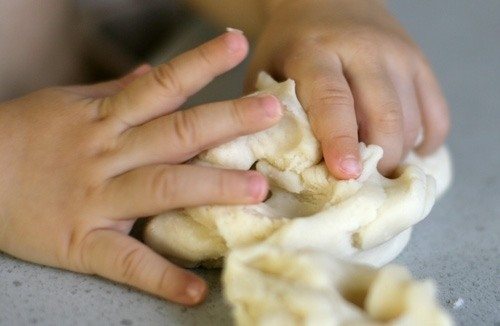
So, what is salted play dough made from? The ingredients are very simple and, best of all, they are available to everyone; you just need to know the exact proportions - and everything will work out!
For one glass of flour, take the same amount of ordinary kitchen salt, mix everything well, add ½ glass of ordinary cold tap water and one tablespoon of sunflower oil. Mix everything thoroughly on a board until it has a homogeneous consistency; if desired, divide it into pieces and add paints of the required colors to them. Then you need to place the finished dough in the refrigerator for 3 hours (after putting it in a plastic bag). The dough will “reach” there, and it will be a pleasure to sculpt from it!
When working with salt dough, in addition to already familiar tools, you must additionally prepare an oilcloth, a glass of water and brushes. Using a brush dipped in water, the separately sculpted parts of the figure will be connected to each other. You need to sculpt from salt dough with dry hands, and the methods and techniques of sculpting are completely no different from those used when working with plasticine. The dough dries out quickly, so it’s better to take the pieces out of the plastic bag in parts.
The finished figure must be thoroughly dried. To do this, you can use the oven at home (low heat for 30-60 minutes, depending on the volume of the figure) or the usual sun! The figurine will dry in the sun for a long time, up to 5 days, you will need to be patient!
Summary of GCD for sculpting “Dog”
Irina Sartakova
Abstract of the educational method for sculpting “Dog”
Goal: To teach children to sculpt a four-legged animal - a dog .
Strengthen sculpting : rolling plasticine between the palms;
practice using pinching and pulling techniques; consolidate the ability to connect parts, pressing them tightly against each other, and smoothing seams; continue to introduce children to the properties of plasticine (soft, pliable, able to take any shape)
; continue to teach how to work with a plasticine stack; develop independence; to cultivate accuracy in working with plasticine, to evoke a positive emotional response to the overall result.
Vocabulary work: stack, plasticine soft, pliable, multi-colored.
Preliminary work: conversations with children about pets, looking at illustrations, reading fiction and educational literature, riddles, didactic games: “Who lives where?”
,
“Where is whose cub?”
,
“Find out by description”
.
Materials: plasticine on boards (for each child)
and separately on plates, stacks, oilcloths, planks.
Features of modeling in kindergarten
Modeling in kindergarten from plasticine, clay or dough plays a significant role in the education and upbringing of preschool children; it is also a type of art.
Modeling for children is part of the fine arts, with the help of which they display their emotions and the real world around them. Children convey their feelings of worldview. Most often, children's creative materials are clay, plasticine, and modeling dough. They are the most convenient for children due to their plastic properties. Even the simplest object or figure is creativity for children.
During the creation of his creative work, the child receives great pleasure from the plastic properties and volumetric shape of the materials used. When sculpting, a child develops his constructive abilities, eye and precision of hand movements. If the teacher organizes the lesson correctly, then modeling will become a favorite hobby for the child. This type of development of creative ability in children aims not only to develop certain skills and abilities in children, but also, as a priority, to prepare the child for school.
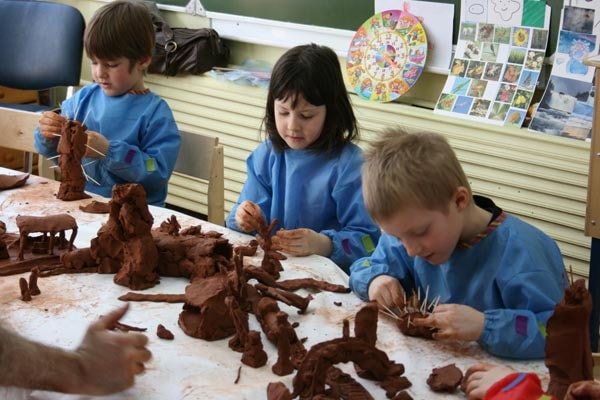
Modeling in kindergarten is used as an aesthetic education for children. Preschoolers are capable of a lot; their abilities depend on knowledge and skills, as well as age characteristics. Taking into account children's age, the shapes of objects and images in their creative solutions are significantly simplified. For example, a person or animal has a round head, cylindrical limbs and torso. Basically, more attention is paid to small, minor details: fins, ears, tail, nose, etc. The child’s main goal is not to create an exact image, but a similar one that he can play with. Most often, children choose to sculpt images from familiar animals that surround them or images of fairy-tale animals from book pictures.
In older preschool age, children already begin to realize what can be beautifully sculpted, and what can be better drawn or made from other materials. During classes, children also master another form of modeling, when they use natural materials and other available materials to create creative works, both to create additional accessories for their figures, and by replacing or supplementing their main components.
There are three types of modeling used in kindergartens:
- Object modeling - the child sculpts a separate object. For children, this is sometimes easier than drawing. Here one figure or image of a person, animal or other object is used, but children begin to produce constructive or plant objects faster and better;
- Plot modeling - depicting the actions of several characters or characters and objects. Subject modeling differs from drawing; there is no background on the plane, zooming out or zooming in with a close-up.
In sculpting, figures have more realistic dimensions and do not depend on the plane. Basically, preschoolers depict a pair of object images that are in a static state. Children do not yet know how to convey other states of images in their creations and do not like to develop plots. For children to play, two characters are enough with whom they will play and even communicate. In the communication between the two characters, there is a plot episode that the child himself comes up with as the action progresses. Already as events develop and acquire greater interest, the child begins to unfold the plot and enrich it with the help of new characters and objects.
Along with play and hobby, plot modeling is a very labor-intensive process for a child. The child will have to create several characters, place them according to the plan and complement the plot with surrounding objects. This is a full-fledged composition presented on a specific platform.
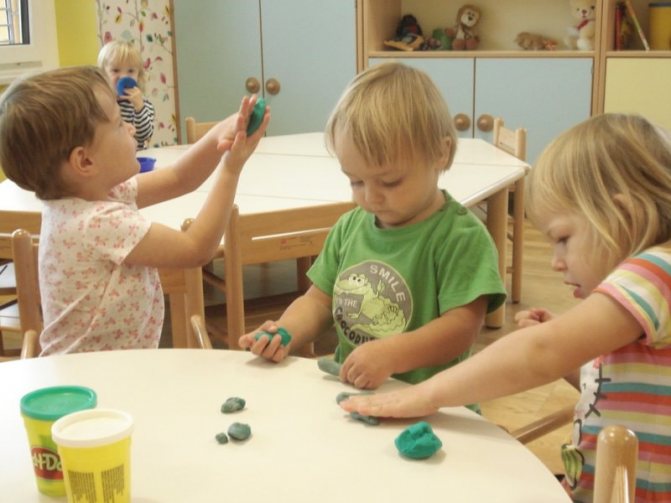
In the child’s mind, at the initial stage, the platform is an ordinary plane on which objects are placed; they are not puzzled by how the bottom should look, attention is concentrated only on the images themselves.
This task faces the teacher of any kindergarten group. He must teach children to design the entire composition: to make a three-dimensional stand with decorative elements, and to logically place objects on the stand correctly.
For example, on a stand there is sculpted soil, grass, flowers, a hole where a fox or mouse lives, a tree with a squirrel. The composition should be similar to a plot from a fairy tale or the surrounding reality. Composition is not only about individual images, but about the relationship between their actions. Plot modeling is only feasible for preschoolers of middle and senior groups, due to its multifaceted diversity, and this requires the necessary knowledge and ideas.
3. Decorative modeling - directly related to the aesthetic education of preschool children, as the teacher introduces and teaches them the creativity of folk craftsmen of various cultures. Modeling is accompanied by painting on the products. Children not only enjoy it, but it also expands their cultural knowledge and fantasy world. Preschoolers love intricate vessels, household items, and dishes with bright colors and a unique appearance.
Older preschoolers, after training with a teacher, are able to create decorative items themselves, which they can play with and even use as design objects to decorate a room, or simply as souvenirs.
With the help of decorative modeling, children learn to think, plan and create sketches of their ideas. Preschoolers should be taught to see beauty with their own eyes. An ordinary salt shaker, mug or vase in the hands of a child, according to the plan and its implementation, can turn into a swan, a plant, or simply become a decorative work of art. Preschoolers use ordinary plasticine, clay and additional accessories to turn an extraordinary thing into something beautiful. In the course of their work, children not only learn how to sculpt, but also how to properly hold and use various tools.
In addition to all the listed advantages, modeling from plasticine develops flexibility, sensitivity and motor skills of the child’s fingers.
Consultation for teachers “Basic methods and techniques in modeling in various age groups”
Oksana Kiryanova
Consultation for teachers “Basic methods and techniques in modeling in various age groups”
Consultation for teachers
Basic methods and techniques in modeling in various age groups
Basic methods and techniques in modeling in various age groups
Modeling is necessary for the development of sensations, perceptions and visual representations in children. It is believed that vision is leading in the knowledge of objects in the real world, but in the first stages of image formation in children, the support for vision is the touch of an object.
I. M. Sechenov o. In modeling, the child must reflect the material properties of bodies - their volume, shape, density, texture. This is possible only when there are already tactile traces in the child’s experience, since the visual reflection of these qualities of an object, unlike the tactile one, is indirect.
Children's visual activities include activities such as drawing, modeling , and appliqué. Each of these types has its own capabilities in reproducing the child’s ideas about the world around him. The working material for modeling can be clay, plasticine or salt dough. The uniqueness of modeling lies in the fact that with the help of this type of activity the shape of an object is conveyed in three dimensions.
Children enjoy sculpting people, animals, dishes, vehicles, vegetables, fruits, and toys. The items they create are used in play activities. During preparation for sculpting , the child gains a lot of knowledge about the subject (name, shape, structure, color, purpose)
.
At the same time, his vocabulary and coherent speech are enriched and developed, with the help of which he can describe the image from memory. This contributes to the development of his thinking, attention, imagination and other processes. During classes, the child receives information about modeling and learns how to do it himself. Based on his experience, he tries to independently solve educational problems, and over time, this independence develops into creativity. In the process of sculpting , more than in any other activity, you can achieve maximum activity of both hands, develop and strengthen your fingers, especially the thumbs, index, and middle ones. To master the sculpting , a child needs to develop special movements regarding their strength, accuracy, tempo, direction, smoothness, and rhythm. These qualities will help the preschooler master various types of educational and work activities in the future. While familiarizing yourself with an object, the child learns to understand its beauty. He himself begins to convey individual expressive features in modeling , tries to carefully treat the surface of the product, decorates it with ornaments, etc. Modeling helps to cultivate curiosity in the visual arts.
The child sets a definite goal for himself and brings the work he has started to the end, and this contributes to the development of organization, determination and perseverance, and disciplines him. Adults need to remember that they must teach a child to sculpt, and not make him a sculptor, and sculpting is not an end in itself , but only a means of comprehensive development and education.
For children three to four years old, it is recommended to sculpt: columns, oranges, cherries, bagels, pretzels, pies, dumplings, etc. Modeling techniques, such as rolling out plasticine with straight and circular movements of the hands, flattening plasticine (sticks, bagels, pretzels, birds, tumblers, mushrooms, pulling small parts (beak, tail, etc.)
.
To work with children of five years old, it is recommended to sculpt: an apple, a carrot, a bowl, a plate, a cup, a glass, etc., where the sculpting of objects is based on the shapes of a cylinder, a cone (vegetables, fruits, toys, etc., sculpting such as rounding and sharpening (carrot, airplane, pressing (basket, cup, saucer, bending edges, connecting parts, dividing plasticine into parts and connecting them by applying, pressing, smearing.
For children six to seven years old, it is recommended to sculpt: parsley, chicken, duck, bird, cat, dog, fox, bear, etc., which show different methods of sculpting : constructive , plastic, combined; techniques for smoothing and tightly connecting parts. of modeling are used for activities with children :
- subject; plot; decorative.
Object modeling in kindergarten is intended to recreate individual objects . Children enthusiastically sculpt figures of people and animals. Only the fastest they master the image of objects of plant and constructive form . In connection with this fact, kindergarten teachers are faced with the task of teaching children the ability to depict the key shape of objects in modeling and the most striking features characteristic of them.
Subject modeling in kindergarten is accompanied by a large amount of work, because it is necessary to sculpt each individual object included in the composition, give it the desired position on a stand or without, and then supplement the modeling with some details .
The teacher needs to teach children the ability to make a dense, fairly voluminous stand and logically, beautifully distribute objects on it. This will make it possible to successfully complete the task of creating a compositional plot.
Most often, the plot for modeling is episodes from the surrounding environment, individual episodes of certain fairy tales and narratives. The expressiveness of plot compositions is given not only by how skillfully the children depict the form, but also by the way they combine the figures into one composition by depicting the action.
Decorative modeling in kindergarten . Introducing children to folk applied art is one of the ways of aesthetic education; in the process of learning its various types , in particular the small decorative plastic arts of folk craftsmen, children can acquire many useful skills. For example, beautiful assembled forms representing animals, dolls, birds with a specific colorful painting amuse children and have a positive effect on the formation of their artistic taste, enriching children's judgment and imagination. When working with children of different ages , you can use the following modeling : constructive , plastic and combined.
Constructive is the simplest of them . The object is molded from separate parts. For example, a bird: first the body, head, and stand are sculpted, and then all the parts are connected and the figure is given characteristic features.
Children use the constructive method of modeling group of kindergarten . This method is used in the future in all age groups , but the number of parts increases, and the methods of connecting parts become more complicated.
The plastic method is more complex. This modeling is made from a whole piece of plasticine, from which all the small details, parts of the product, etc. are pulled out. Children begin to sculpt in this way from the middle group (vegetables, fruits, toys)
.
For example, while sculpting a mouse from a common piece of plasticine, a child creates the desired shape, draws out its muzzle, ears, tail, paws and, using a stick, gives it characteristic features. Children sculpt using plastic methods throughout preschool age . The collection presents examples of making objects using this method , such as a duck, a pig, etc.
The combined method combines modeling from a whole piece of plasticine and from individual parts or parts. For example, from a piece of plasticine we sculpt part of a chicken: the body, the head, and we prepare the small parts and the stand separately, then we connect them.
In addition, when making birds, animals, and people, relief modeling : small pieces of clay or plasticine are placed on the main form , and then smeared with a stack or fingers. After which the product is given the desired shape, these are: tit, bullfinch, snow maiden, grapes, etc. The working material for modeling can be clay, plasticine or salt dough.
Basic sculpting techniques:
Pinching is the separation of small pieces from a large piece of plasticine using the thumb and index finger. To do this, first pinch a small piece from the edge of a large piece and then tear it off.
Flattening - compressing a piece to give it a flat shape. A small piece is flattened with two fingers - the thumb and forefinger. The middle piece is pressed down using the palm of your hand and a flat surface.
Rolling Forming large or small balls by making circular movements between straight palms or palm and table.
Indentation: By pressing the thumb or index finger on the lump, a small indentation is made
Sharpening - with one or two or three fingers, press the piece on all sides until a sharp end is obtained.
Rolling is the formation of “sausages”
(cylindrical shapes of different sizes)
by rolling it back and forth between straight palms or palm and table.
Connection - pressing the parts of the craft to one another, then lightly pressing them against each other and carefully smoothing the joint.
Pinching - using the thumb and forefinger, a small edge is pulled back and sharpened.
Recommendations for working with plasticine: Before class, warm up hard plasticine in a container with hot tap water (but do not pour boiling water over it)
.
When working with plasticine, you should use thick cardboard as a base , not thin sheets of paper, so that it does not deform when performing techniques of pressing , smearing, and smoothing the surfaces of the objects .
To ensure that the picture does not lose its attractiveness over time, the base with or without a pre-drawn outline should be covered with tape. This will help avoid the appearance of greasy stains, it will be easier to work on a slippery surface, and using a stack it will be easier to remove excess plasticine without leaving marks.
There must be a cloth hand napkin on the child’s desk so that he can use it at any time, and after completing work, first wipe his hands with a napkin and then wash them with soap and water. Working with plasticine requires physical effort, so in the process of doing it, children need rest in the form of physical education and warm-ups. In older preschool age , when children have mastered all the traditional techniques of working with plasticine, you can offer modeling on a frame using a three-core wire as a base It is believed that vision is the leader in the knowledge of objects in the real world, but in the first stages of image formation in children, the support is the touch of an object. I. M. Sechenov o. What can give a better idea of an object than to create this object from a nondescript piece of clay or plasticine, making it recognizable and attractive. This explains the enormous interest of children of all ages in modeling .
Equipment and materials for modeling classes in kindergarten
Typically, kindergarten groups use plasticine, but the possibilities of working with it are limited. The most effective way to use clay in creative work. Fat clay is best. You can sculpt several large objects from it, create objects with subsequent heat treatment for immortalization and paint them. The plasticity of clay can be adjusted with water, which makes the work easier for children.
In education, it is more practical to use clay, since plasticine is intended for small products, and small forms are not able to convey the fullness and clarity of the lines of the details of the figure. Using plasticine complicates activities with young children, since it is quite hard and needs to be constantly kneaded to make it soft, and small children are not always able to do this. Plasticine modeling is more suitable for children with developed finger muscles, at an older age of 5-7 years, but its use should be limited to only a small number of activities.
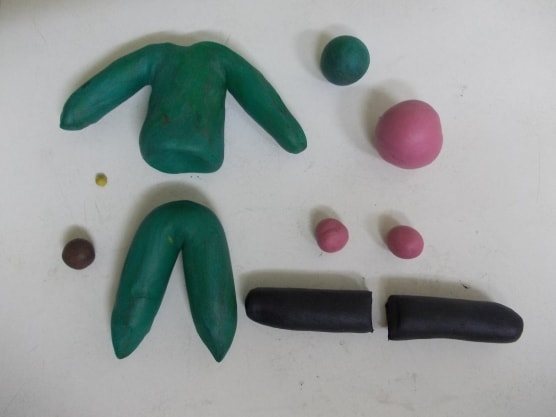
If the kindergarten has enough budgetary funds, then clay can be purchased at the store, but in rural areas it is easier to dig it up. The clay layer is located directly under the fertile soil layer, so this will not be particularly difficult. Preparing the mixture for modeling is also not difficult. You just need to add water to the clay and knead it, and then put it in a thick cellophane bag, and then the working material can be stored for a whole year. To fire clay, you only need to spend money on a muffle furnace. You will also need paint. Thus, after processing, children's crafts will turn into real ceramic products and souvenirs. Clay itself in its raw form is not a load-bearing material and to make products you will need to stock up on frames.
Ordinary sticks or pieces of wire can serve as frames. The frame must be made in such a way that it can be removed from the product after the clay dries, otherwise the clay on the frame may crack when drying. To draw out individual elements and recesses, you can use plastic knives like in plasticine, spatulas and nails. The better and more conveniently the place for a child’s creative activity is organized, the better the quality of his work. Usually boards are used for the working surface, but it is better to have a rotary machine for ease of working on the product from any side.
In the end, I would like to add that modeling in kindergarten is important for preschoolers for the development of sensory perception. Children must not only see, but also touch objects.
Modeling: lesson notes, programs, clubs, planning
Contained in sections:
- ISO. Visual activities in kindergarten
- ISO. Lesson notes for fine arts in kindergarten
Includes sections:
- Crafts made from salt dough. Classes, master classes
- Insects. Modeling from plasticine on the theme “Insects”
- Clay crafts
- Plasticine, we sculpt from plasticine. Crafts
By groups:
- Senior group
- Preparatory group
- Middle group
- Junior group
Showing publications 1-10 of 8915. All sections | Modeling. Lesson notes, projects
New Photo Best
Summary of a modeling lesson in the nursery group “Watermelon Slice”
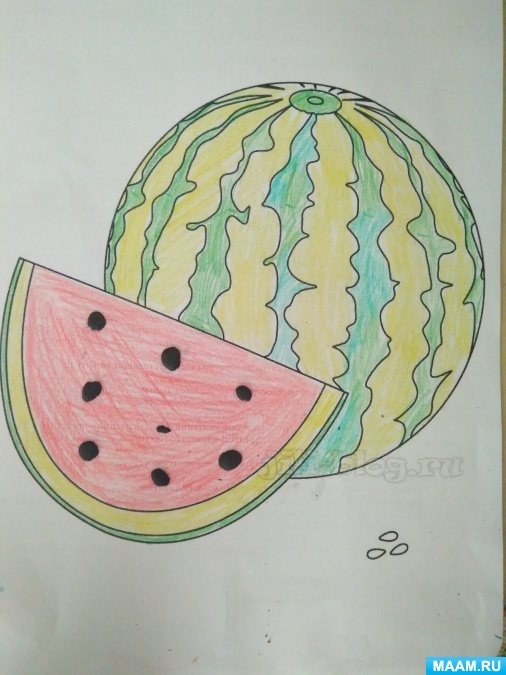
Topic: “Watermelon Slice” Objectives: 1. To arouse interest in creating bright, colorful work. 2. Learn to decorate a template of a watermelon slice (prepared in advance, using black plasticine. Preliminary work: 1. Reading fiction 2. Looking at paintings and photos depicting…
Summary of a modeling lesson in a preparatory group on the topic “Jellyfish at the bottom of the sea”
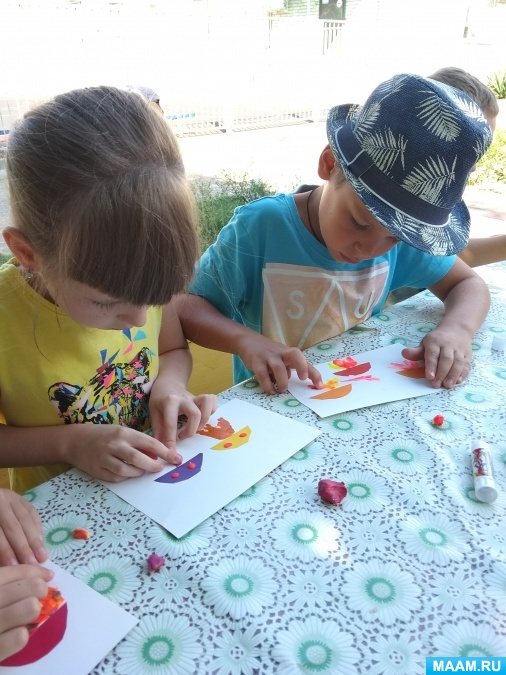
Methods and techniques of sculpting
⇐ PreviousPage 3 of 3
Author: Posted in: Fine Arts
Methods and techniques of modeling in different age groups of kindergarten. Worked on the issue: Khalizova N.B.; Kasminskaya V.B.
Modeling is a type of visual activity in which objects are conveyed three-dimensionally, three-dimensionally, using soft plastic materials (clay, plasticine, dough). Modeling from hard materials is called sculpting. In kindergarten, plasticine and clay are mainly used. They start modeling at the age of 2. Type of modeling – subject. In the middle group - plot modeling, two objects (for example, a bun met a hare). In the older group there is decorative modeling, which requires decoration. In the preparatory group - all types of modeling. There are 3 methods of sculpting: 1. constructive - the object is divided from separate parts, then fastened together; 2. plastic - modeling from a single piece, by transformation; 3. combined - a combination of constructive and plastic methods. Modeling in the first junior group. The sculpted works of children are characterized by an indistinct form, because children work with the whole hand, since the movements of the fingers are not yet developed and poorly coordinated. During this period, they mainly introduce clay and perform playful actions with it (flatten it, tear off lumps). The children are not given the goal of depicting anything. This period is called pre-fine. Under the guidance of the teacher, children gradually begin to depict certain objects. Objectives: 1. to interest children in a new activity - modeling; 2. introduce children to materials and show their visual capabilities; 3. instill in children the desire to sculpt simple objects themselves; 4. teach the simplest technical techniques (tearing off, rolling out, connecting parts); 5. teach children to follow certain rules and work culture (work on a board, don’t throw it around, don’t get dirty). The program is given for the whole year and is not distributed quarterly. Methods and techniques. Children are divided into small subgroups, 5-6 people. The lesson is held for 5-8 minutes with each subgroup. From the second half of the year, classes are held frontally. The main technique is a demonstration and a detailed explanation of one’s actions (“I take a piece of plasticine on my left palm, cover it with my right palm and roll it back and forth...). You can conduct classes demonstrating the process of depicting objects familiar to children. Using gaming techniques and playing them out. As they acquire skills in working with clay, children can sculpt according to their own plans, but at the same time remind them that we were sculpting before (for example, breadsticks, sausages, pencils, balls, etc., and now sculpt who will do what) . Positive assessment of children's activities. Modeling in the second junior group. Children in this group are more prepared for modeling classes. Classes are conducted with the whole group (frontal). Children are familiar with the material and know what can be sculpted. However, there is still no connection between the movement of the hands and the shape (if it’s a ball, he won’t be able to figure out how to roll it). Software learning objectives. I quarter: 1. improve children’s ability to roll a lump of clay between their palms with straight movements (pencils, fence posts, sausages); 2. teach children to connect the ends of the roller to make a ring (donut, bagels, wheels); 3. teach children to roll out a cone-shaped shape (carrot) between their palms by pulling out one side; 4. learn to sculpt round objects, roll a lump of clay in a circular motion (balls, balls, apples); 5. teach children to sculpt objects consisting of several parts (pyramid, snowman), placing one part on top of another and pressing it down (connecting parts). II quarter: 1. teach children to flatten a ball to obtain a disk (pancakes, flatbreads, cake, decorating with small balls; 2. teach children to pinch the edges of the shape with their fingers from a common piece of clay (saucer; pinch the cut to make a dumpling; pies - pinch the scallop on top) III quarter: teach children to sculpt objects consisting of several parts, the same and different shapes (mushroom, tumbler, pyramid, matryoshka, basket). IV quarter: in the summer, the knowledge acquired during the year is consolidated. Methods and techniques of teaching. 1. examination of the object (the child traces the object, rolls it between his palms to feel the shape); 2. demonstration and explanation; 3. playing techniques 4. analysis of all works (positive). Modeling in the middle group. In children of the fifth year of life, the muscular system has become sufficiently strong hands, the vocabulary has expanded, and in connection with this, the regulating role of speech has appeared (they plan their work, understand the teacher better).Children begin to highlight the functional characteristics of an object, this facilitates the process of depiction. Children become more attentive to the lesson process. However, the result of the work is still little different from the younger group, because Children do not yet master the methods of representation. Children do not have a clear idea of objects and shapes, structure, proportions are violated, there is no clarity in conveying the form, parts are not firmly held together (fastening by smoothing). Objectives: 1. continue to cultivate in children a sustainable interest in modeling classes; 2. clarify ideas about the shapes of objects, their structure, proportions and details; 3. teach children technical skills (sculpt shapes with your fingers, tightly fasten parts, make small parts by pinching); 4. teach children to independently use some modeling methods and choose a topic in classes according to their own ideas. Modeling in the senior group. By the age of 6, children have accumulated some experience in modeling. Their products have become more diverse, not only in content, but also in the way they are depicted. During this period, the process of ossification of the hand begins, small and large muscles become stronger. This makes it possible for more precise and complex actions with clay. Changes also occur in the psyche of children, attention becomes more stable, memory improves, children can imagine an object and then sculpt it. Movements during sculpting are more accurate, as visual control over the actions of the fingers has increased. However, when creating an object, children work little to clarify the shapes. This is explained by the fact that the presence of parts of an object and purely external signs of forms are important for them. Based on formed visual images, children often sculpt objects in motion, but, as a rule, they do not think about the action in advance. The content of classes in the older group becomes more and more complicated, children 5-6 years old sculpt various shapes, simple plots, and decorative modeling (decorating objects) appears. Children in the older group sculpt more according to idea and design. Objectives: 1. continue to maintain children’s interest in modeling classes; 2. teach children to convey the basic character of forms (proportions, structure, the most characteristic details) during the image; 3. teach children to create story compositions; 4. teach children decorative modeling: decorate products with moldings, in-depth relief, paint with gouache or engobes (a dye made from clay of a different color); 5. teach children the plastic method of modeling, i.e. sculpting from a whole piece. I quarter. At the beginning of the year, children sculpt the simplest, most familiar objects and learn to convey characteristic details. In order for children to learn to convey the character of a form, they sculpt not one object, but several, with a clearly defined shape (pear, apple, carrot, beet). Children also sculpt figures, both from a whole piece and in parts (swan, rooster, duck), as well as human figures. II quarter. Children sculpt animal figures (in parts). A sculpture of a human figure appears and is placed on its feet. You can convey the movements of these figures (put them on a sled; when sculpting a snow woman, the girl leans on a snowball). To stabilize the figure, you can use a third fulcrum (Santa Claus has a staff, Snow Maiden has a Christmas tree). Subject sculpting - first a 1-1.5cm stand is sculpted. – thick, figures stick to it. The program for the senior group involves sculpting dishes in a new way, called tape (the bottom is sculpted first, then everything else). It is advisable to decorate the dishes, sometimes they are painted (in drawing). With children you can make various decorative items (beads, pendants, dishes, trays). III quarter. Children's knowledge about the environment expands and their modeling skills improve. The figures become more expressive. Most of the classes are devoted to plot modeling (based on fairy tales). Children sculpt according to the idea. IV quarter. Only consolidation of acquired knowledge, skills and abilities. Methods and techniques of teaching. Use of nature. Full demonstration of image techniques is almost never used in the older group. Only new moves are shown. The conversation is aimed at deciding on the composition (what kind of stand it should be, how to apply it). Game techniques are used (for example, “guys, today we will be potters”). Artistic words (riddles, poems) are used. Analysis of children's works. What did we do? What was the task? Say what worked out well and what didn’t, without naming the specific names of the children. Modeling in the preparatory group. Children's sculptures are more expressive, more interesting, and more varied, since children have accumulated a stock of ideas. During observations, children more fully perceive the phenomena of the surrounding reality and are better oriented in space. Children have a desire to convey shape, proportions, and details that complement the image; they can more accurately convey movements. But despite this, the shape of objects remains just as generalized. This indicates that children of 6 years old do not yet have access to a complete image of all the features of the form; they only sculpt its basis. Tasks. 1. Learn to convey the characteristic movements of humans and animals (a horse gallops, a girl dances); 2. To develop in children a sense of composition, to sculpt structural groups of 2-3 figures, to convey proportions, dynamics, and the ratio of objects in size; 3. Learn to sculpt dishes in different ways (ribbon, circular, clay casting); 4. Continue to teach children how to perform decorative modeling in different ways; 5. Learn to sculpt objects from imagination and from life. I quarter. The teacher is faced with the task of teaching children to sculpt objects of characteristic shapes. At the beginning of the year, they are asked to sculpt two similar objects, but of different shapes (2 apples: one elongated, the other round; 2 tomatoes, etc.). Teach children to sculpt objects in motion (2 cockerels: one singing, the other pecking grains). Children sculpt human figures. It is proposed to sculpt while respecting the proportions. In addition, children sculpt various animals. II quarter. The main focus is on sculpting plot compositions. They teach how to sculpt dishes in two new ways: sculpting from rings, choosing clay - the outer shape is sculpted, and then the inside is rubbed with a stapler, an internal recess is made. Before decorating, the product is leveled to create a smooth surface. Decorative work - based on clay samples. III quarter. Much attention is paid to teamwork (poultry farm, zoo, football field). Measurements are given to know each figure size. Pictures and subject situations are offered, children choose what they like and sculpt.
⇐ Previous3
Recommended pages:
Modeling technique in the middle group
Exercises with plastic materials prepare a child’s hand for mastering the most important skill in the near future - writing. Regular sculpting exercises develop hand flexibility and precision of movements. The kids create crafts by studying various modeling techniques.
Table: methods and techniques of sculpting
| Modeling methods | Techniques | Examples of crafts in the middle group |
| Sculptural/plastic - sculpted from one piece. |
|
|
| Constructive - creating a craft from several parts. | Plastic molded parts are connected to each other. |
|
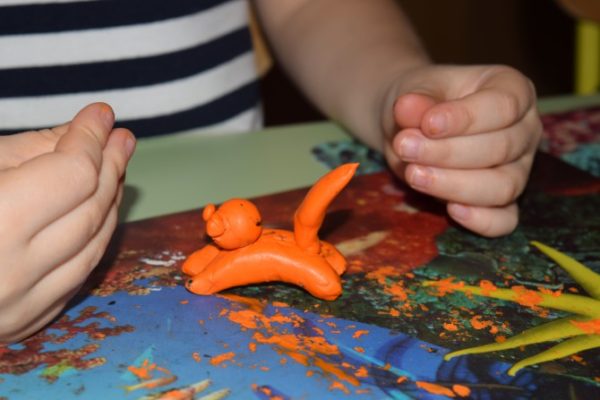
In the middle group, children master the constructive method of modeling: sculpting and combining parts into a single image
Types of modeling
- Subject modeling. In the middle group, children sculpt two- and three-dimensional objects on a plane. They try to convey the shape of familiar objects as accurately as possible. There is always a sample in the classroom - a figurine or toy.
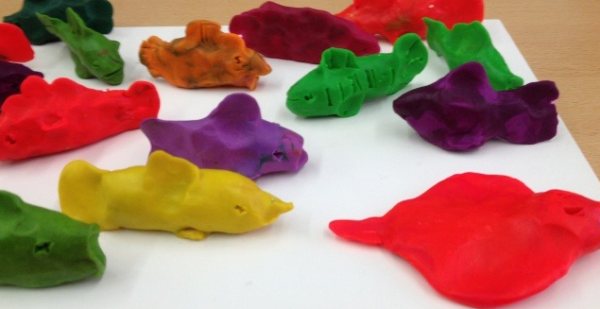
Object modeling also implies the image of living creatures, for example, fish
- Subject modeling. In the fifth year of life, thinking abilities rapidly develop. The child compares objects in the surrounding world, discovers connections and interactions between them. The first subjects are collective compositions “Round Dance of the Hares”, “Bird Yard”.
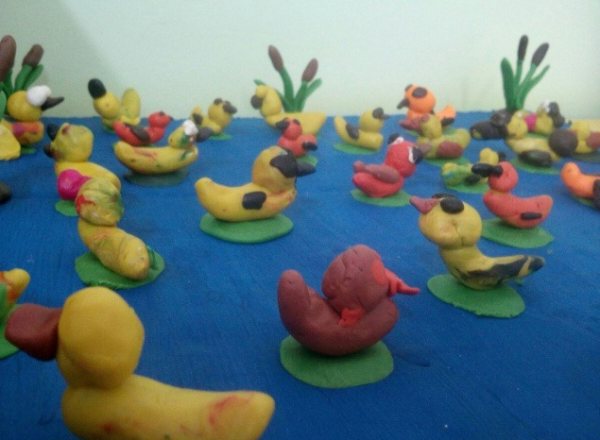
Collective works have a simple plot, for example, “Ducklings swim on the pond”
- Decorative modeling. In the middle group, this type of modeling can be used to decorate “Vase” and “Plate” crafts.
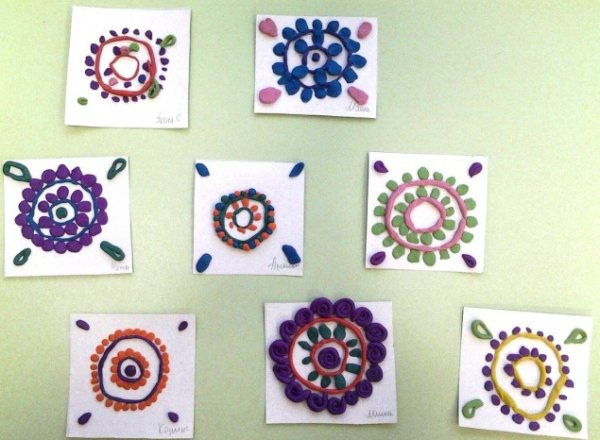
Children 4–5 years old learn to decorate surfaces with a relief pattern, for example, as in the lesson “Miracle Flower”
Materials and tools
- Plasticine is the most malleable material. It is possible to introduce children to clay, but it is recommended to sculpt with it in the senior and preparatory groups (with children 5–7 years old). Occasionally, Play Doh plasticine may be used in classes. This is an expensive material, but bright and unusual. You can use it to decorate gifts for mothers on March 8, for example.
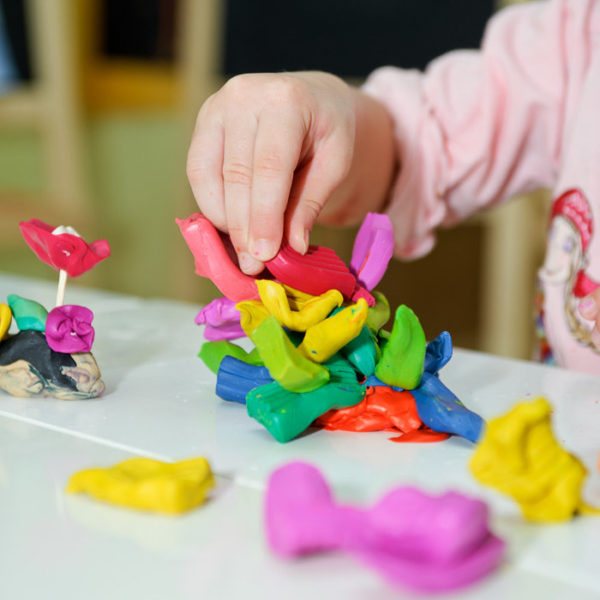
Save leftover playdough from their sets - children will use them later
- The stack is an assistant instrument that children become familiar with in the middle group. The teacher shows how to hold the stack and how to use it to cut off a piece of plasticine/dough. The stack will be needed to complement crafts with cuts or simple patterns (dots, lines). They represent the eyes, mouth, and nose on the faces of animals.
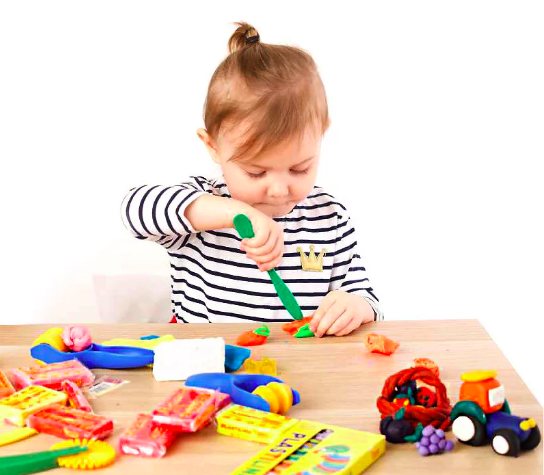
For the middle group, it is recommended to purchase plastic stacks with a rounded end
Unconventional sculpting techniques
- Plasticine mosaic - laying out plasticine balls on a drawn image. In technical terms, the use of this technique in classes in the middle group does not give anything new to children. It is appropriate to do plasticine mosaics during decorative modeling. For example, children will decorate plastic plates or lids with mosaics.
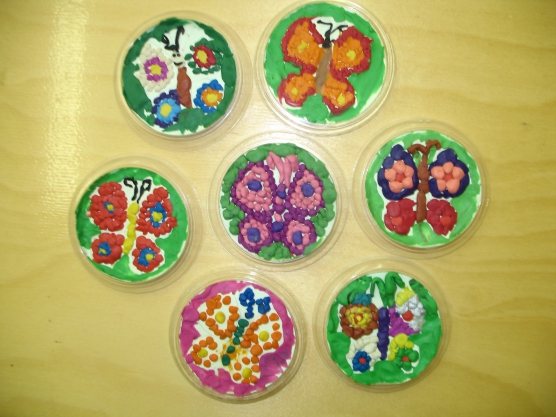
Mosaic is great for decorating plastic and cardboard surfaces
- Plasticineography - drawing or painting over contours by smearing and/or sticking plasticine. In the middle group, small pictures are selected on a thick sheet of paper or cardboard. The task for children 4–5 years old is to “color” the drawing with a thin layer of plasticine, without going beyond the contours. Children choose their own colors for plasticine printing.
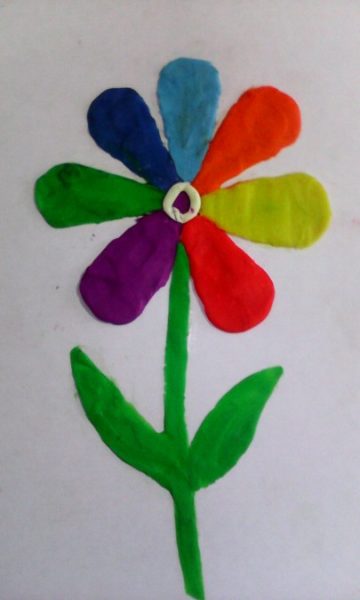
Children use plasticine to color simple images, for example, a seven-flowered flower.
- Testoplasty - modeling from salt dough. In the middle group, crafts “Treats for dolls/friends” and “Caterpillar” are made using this technique. Salt dough is a wonderful alternative to plasticine, a completely natural material. The teacher prepares the dough immediately before class.
Salt dough recipe: 1/2 tbsp. cold water, 1 tbsp. flour, 1 tbsp. salt Stir until smooth.
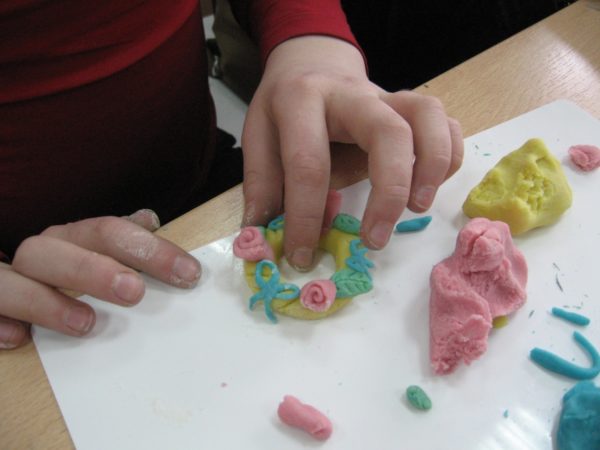
You can add food coloring to salt dough
Salt dough tends to crumble while working. For children 4–5 years old, this material cannot be called pliable. Therefore, to the mass obtained according to the classic recipe, I add 1-2 tablespoons of vegetable oil (odorless). The dough becomes more flexible.
Task differentiation
During the school year, the teacher evaluates the effectiveness of classes. In September, January and May, children's visual abilities are monitored. The level of mastery of practical skills for each student is determined.
Practical skills are formed and consolidated unevenly among children of the same age. This is fine. The teacher’s task is to create favorable conditions for the development of each student. Taking into account personal qualities and the pace of mastering modeling techniques, the teacher develops multi-level tasks.
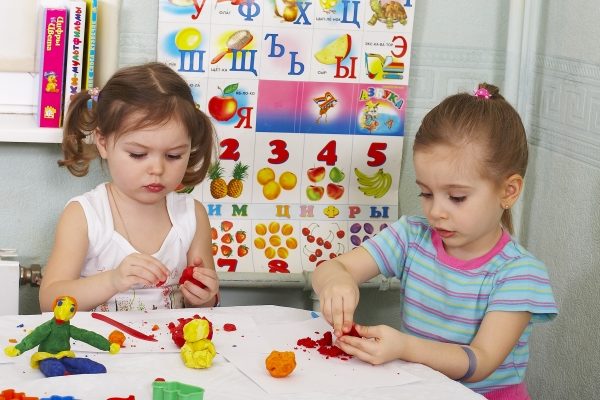
During the lesson, the child gains new experience and positive emotions; tasks are selected according to their level of development.
Table: examples of tasks of different difficulty levels
| Ability criterion | Main quest | Complicated task |
| The ability to determine what parts and shapes an object for modeling consists of | Make a fly agaric: a cylinder leg, a cone-shaped cap, white dots. | Make a fly agaric, secure it on a cardboard base, add a blade of grass/leaves/stump. |
| Sculpting speed | Make a duckling: plastically mold the head and body, add wings and beak. | Make a duckling, use a stack to make cuts on the wings and tail (feathers), and mark the eyes. |
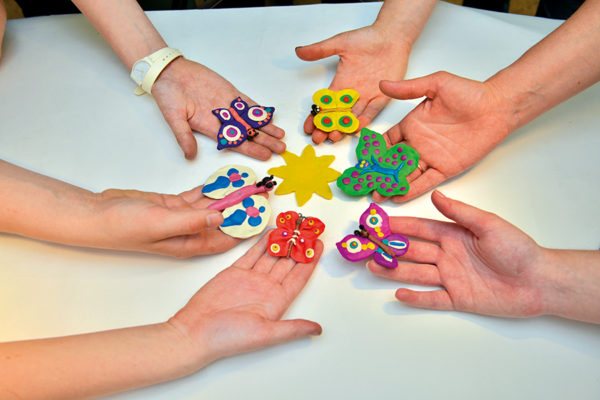
Multi-level tasks are necessary for each child to demonstrate their skills and feel successful.
LiveInternetLiveInternet
Modeling is necessary for the development of sensations, perceptions and visual representations in children. It is believed that vision is leading in the knowledge of objects in the real world, but in the first stages of image formation in children, the support for vision is the touch of an object.
THEM. Sechenov O.
In modeling, the child must reflect the material properties of bodies - their volume, shape, density, texture. This is possible only when there are already tactile traces in the child’s experience, since the visual reflection of these qualities of an object, unlike the tactile one, is indirect.
Children's visual activities include activities such as drawing, modeling, and appliqué. Each of these types has its own capabilities in reproducing the child’s ideas about the world around him.
The working material for modeling can be clay, plasticine or salt dough. The uniqueness of modeling lies in the fact that with the help of this type of activity the shape of an object is conveyed in three dimensions.
Children enjoy sculpting people, animals, dishes, vehicles, vegetables, fruits, and toys. The items they create are used in play activities.
During preparation for modeling, the child receives a lot of knowledge about the subject (name, shape, structure, color, purpose). At the same time, his vocabulary and coherent speech are enriched and developed, with the help of which he can describe the image from memory. This contributes to the development of his thinking, attention, imagination and other processes.
During classes, the child receives information about modeling methods and learns how to do it himself. Based on his experience, he tries to independently solve educational problems, and over time, this independence develops into creativity.
In the process of sculpting, more than in any other activity, you can achieve maximum activity of both hands, develop and strengthen your fingers, especially the thumbs, index, and middle ones. To master the sculpting technique, a child needs to develop special movements regarding their strength, accuracy, tempo, direction, smoothness, and rhythm. These qualities will help the preschooler master various types of educational and work activities in the future.
While familiarizing yourself with an object, the child learns to understand its beauty. He himself begins to convey in the sculpting its individual expressive features, tries to carefully treat the surface of the product, decorates it with ornaments, etc.
Modeling helps to cultivate curiosity in the visual arts. The child sets a definite goal for himself and brings the work he has started to the end, and this contributes to the development of organization, determination and perseverance, and disciplines him.
Adults need to remember that they must teach a child to sculpt, and not make him a sculptor, and sculpting is not an end in itself, but only a means of comprehensive development and education.
For children three to four years old, it is recommended to sculpt: columns, oranges, cherries, bagels, pretzels, pies, dumplings, etc. Modeling techniques, such as rolling out plasticine with straight and circular movements of the hands, flattening plasticine (sticks, bagels, pretzels, birds, tumblers, mushrooms), pulling back small parts (beak, tail, etc.).
To work with children of five years old, it is recommended to sculpt: an apple, a carrot, a bowl, a plate, a cup, a glass, etc., where the sculpting of objects is based on the shape of a cylinder, a cone (vegetables, fruits, toys, etc.), sculpting techniques such as rounding and pointing (carrot, airplane), pressing (basket, cup, saucer), bending edges, connecting parts, dividing plasticine into parts and connecting them by applying, pressing, smearing.
For children six to seven years old, it is recommended to sculpt: parsley, chicken, duck, bird, cat, dog, fox, bear, etc., which show different methods of sculpting: constructive, plastic, combined; techniques for smoothing and tightly connecting parts.
Three types of modeling are used for activities with children:
- subject;
- plot;
- decorative.
Object modeling in kindergarten is intended to recreate individual objects. Children enthusiastically sculpt figures of people and animals. Only the fastest they master the image of objects of plant and structural form. In connection with this fact, kindergarten teachers are faced with the task of teaching children the ability to depict the key shape of objects in modeling and the most striking features characteristic of them.
Subject modeling in kindergarten is accompanied by a large amount of work, because it is necessary to sculpt each individual object included in the composition, give it the desired position on a stand or without, and then supplement the modeling with some details.
The teacher needs to teach children the ability to make a dense, fairly voluminous stand and logically, beautifully distribute objects on it. This will make it possible to successfully complete the task of creating a compositional plot.
Most often, the plot for modeling is episodes from the surrounding environment, individual episodes of certain fairy tales and narratives. The expressiveness of plot compositions is given not only by how skillfully the children depict the form, but also by the way they combine the figures into one composition by depicting the action.
Decorative modeling in kindergarten. Introducing children to folk applied art is one of the ways of aesthetic education; in the process of learning its various types, in particular the small decorative plastic arts of folk craftsmen, children can acquire many useful skills. For example, beautiful assembled forms representing animals, dolls, birds with a specific colorful painting amuse children and have a positive effect on the formation of their artistic taste, enriching children's judgment and imagination.
When working with children of different ages, you can use the following modeling methods: constructive, plastic and combined.
Constructive is the simplest of them. The object is molded from separate parts. For example, a bird: first the body, head, and stand are sculpted, and then all the parts are connected and the figurine is given characteristic features. Children use the constructive method of modeling in the younger group of kindergarten. This method is used in the future in all age groups, but the number of parts increases, and the methods of connecting parts become more complicated.
The plastic method is more complex. This modeling is made from a whole piece of plasticine, from which all the small details, parts of the product, etc. are pulled out. Children begin to sculpt in this way from the middle group (vegetables, fruits, toys). For example, while sculpting a mouse from a common piece of plasticine, a child creates the desired shape, draws out its muzzle, ears, tail, paws and, using a stick, gives it characteristic features. Children sculpt using plastic methods throughout preschool age. The collection presents examples of making objects using this method, such as a duck, a pig, etc.
The combined method combines modeling from a whole piece of plasticine and from individual parts or parts. For example, from a piece of plasticine we sculpt part of a chicken: the body, the head, and we prepare the small parts and the stand separately, then we connect them.
In addition, when making birds, animals, and people, relief modeling techniques are used: small pieces of clay or plasticine are placed on the main form, and then smeared with a stick or fingers. After which the product is given the desired shape, these are: tit, bullfinch, snow maiden, grapes, etc. The working material for modeling can be clay, plasticine or salt dough.
Basic sculpting techniques
Modeling techniques
Description
Pinching off
Separating small pieces from a large piece of plasticine using the thumb and index finger. To do this, first pinch a small piece from the edge of a large piece and then tear it off.
Flattening
Compressing a piece to make it flat. A small piece is flattened with two fingers - the thumb and forefinger. The middle piece is pressed down using the palm of your hand and a flat surface.
Rolling up
Forming large or small balls by using circular movements between straight palms or palm and table.
Indentation
By pressing the thumb or index finger on the lump, a small indentation is made
Sharpening
With one or two or three fingers, press the piece on all sides until you get a sharp end.
Rolling out
Forming a piece into “sausages” (cylindrical shapes of different sizes) by rolling it back and forth between straight palms or palm and table.
Compound
Pressing the parts of the craft one against the other, then lightly pressing them together and carefully smoothing the joint.
Topping
Using the thumb and forefinger, a small edge is pulled back and sharpened.
Recommendations for working with plasticine:
Before class, warm up hard plasticine in a container with hot tap water (but do not pour boiling water over it).
When working with plasticine, you should use thick cardboard as a base, not thin sheets of paper, so that it does not deform when performing techniques of pressing, smearing, and smoothing the surfaces of the objects being created.
To ensure that the picture does not lose its attractiveness over time, the base with or without a pre-drawn outline should be covered with tape. This will help avoid the appearance of greasy stains, it will be easier to work on a slippery surface, and using a stack it will be easier to remove excess plasticine without leaving marks.
There must be a cloth hand napkin on the child’s desk so that he can use it at any time, and after completing work, first wipe his hands with a napkin and then wash them with soap and water.
Working with plasticine requires physical effort, so in the process of doing it, children need rest in the form of physical education and warm-ups.
In older preschool age, when children have mastered all the traditional techniques of working with plasticine, you can offer modeling on a frame, using a three-core wire as a base.
It is believed that vision is the leader in the knowledge of objects in the real world, but in the first stages of image formation in children, the support is the touch of an object. THEM. Sechenov O. What can give a better idea of an object than to create this object from a nondescript piece of clay or plasticine, making it recognizable and attractive. This explains the great interest of children of all ages in modeling.
Literature.
1. Beloshistaya A.V., Zhukova O.G. - M: ARKTI, 2007.
2. Davydova G.N. Plasticineography for kids. M.: “Scriptorium 2003”, 2008.
3. Davydova G.N. Plasticineography. Animal painting. M.: “Scriptorium 2003”, 2008.
4. Lykova I.A. Visual activities in kindergarten. M.: “Karapuz - didactics”, 2007.
5. Miloserdova N.E. Teaching preschoolers modeling techniques. M.: TsPO, 2008
https://kopilkaurokov.ru/vneurochka/prochee/osnovn...lichnykh-vozrastnykh-ghruppakh
Basic methods and techniques in modeling in various age groups
Modeling is necessary for the development of sensations, perceptions and visual representations in children. It is believed that vision is leading in the knowledge of objects in the real world, but in the first stages of image formation in children, the support for vision is the touch of an object.
THEM. Sechenov O.
In modeling, the child must reflect the material properties of bodies - their volume, shape, density, texture. This is possible only when there are already tactile traces in the child’s experience, since the visual reflection of these qualities of an object, unlike the tactile one, is indirect.
Modeling techniques
| Children's visual activities include activities such as drawing, modeling, and appliqué. Each of these types has its own capabilities in reproducing the child’s ideas about the world around him. The working material for modeling can be clay, plasticine or salt dough. The uniqueness of modeling lies in the fact that with the help of this type of activity the shape of an object is conveyed in three dimensions. Children enjoy sculpting people, animals, dishes, vehicles, vegetables, fruits, and toys. The items they create are used in play activities. During preparation for modeling, the child receives a lot of knowledge about the subject (name, shape, structure, color, purpose). At the same time, his vocabulary and coherent speech are enriched and developed, with the help of which he can describe the image from memory. This contributes to the development of his thinking, attention, imagination and other processes. During classes, the child receives information about modeling methods and learns how to do it himself. Based on his experience, he tries to independently solve educational problems, and over time, this independence develops into creativity. In the process of sculpting, more than in any other activity, you can achieve maximum activity of both hands, develop and strengthen your fingers, especially the thumbs, index, and middle ones. To master the sculpting technique, a child needs to develop special movements regarding their strength, accuracy, tempo, direction, smoothness, and rhythm. These qualities will help the preschooler master various types of educational and work activities in the future. While familiarizing yourself with an object, the child learns to understand its beauty. He himself begins to convey in the sculpting its individual expressive features, tries to carefully treat the surface of the product, decorates it with ornaments, etc. Modeling helps to cultivate curiosity in the visual arts. The child sets a definite goal for himself and brings the work he has started to the end, and this contributes to the development of organization, determination and perseverance, and disciplines him. Adults need to remember that they must teach a child to sculpt, and not make him a sculptor, and sculpting is not an end in itself, but only a means of comprehensive development and education. For children three to four years old, it is recommended to sculpt: columns, oranges, cherries, bagels, pretzels, pies, dumplings, etc. Modeling techniques, such as rolling out plasticine with straight and circular movements of the hands, flattening plasticine (sticks, bagels, pretzels, birds, tumblers, mushrooms), pulling back small parts (beak, tail, etc.). To work with children of five years old, it is recommended to sculpt: an apple, a carrot, a bowl, a plate, a cup, a glass, etc., where the sculpting of objects is based on the shape of a cylinder, a cone (vegetables, fruits, toys, etc.), sculpting techniques such as rounding and pointing (carrot, airplane), pressing (basket, cup, saucer), bending edges, connecting parts, dividing plasticine into parts and connecting them by applying, pressing, smearing. For children six to seven years old, it is recommended to sculpt: parsley, chicken, duck, bird, cat, dog, fox, bear, etc., which show different methods of sculpting: constructive, plastic, combined; techniques for smoothing and tightly connecting parts. Three types of modeling are used for activities with children:
Object modeling in kindergarten is intended to recreate individual objects. Children enthusiastically sculpt figures of people and animals. Only the fastest they master the image of objects of plant and structural form. In connection with this fact, kindergarten teachers are faced with the task of teaching children the ability to depict the key shape of objects in modeling and the most striking features characteristic of them. Subject modeling in kindergarten is accompanied by a large amount of work, because it is necessary to sculpt each individual object included in the composition, give it the desired position on a stand or without, and then supplement the modeling with some details. The teacher needs to teach children the ability to make a dense, fairly voluminous stand and logically, beautifully distribute objects on it. This will make it possible to successfully complete the task of creating a compositional plot. Most often, the plot for modeling is episodes from the surrounding environment, individual episodes of certain fairy tales and narratives. The expressiveness of plot compositions is given not only by how skillfully the children depict the form, but also by the way they combine the figures into one composition by depicting the action. Decorative modeling in kindergarten. Introducing children to folk applied art is one of the ways of aesthetic education; in the process of learning its various types, in particular the small decorative plastic arts of folk craftsmen, children can acquire many useful skills. For example, beautiful assembled forms representing animals, dolls, birds with a specific colorful painting amuse children and have a positive effect on the formation of their artistic taste, enriching children's judgment and imagination. When working with children of different ages, you can use the following modeling methods: constructive, plastic and combined. Constructive is the simplest of them. The object is molded from separate parts. For example, a bird: first the body, head, and stand are sculpted, and then all the parts are connected and the figurine is given characteristic features. Children use the constructive method of modeling in the younger group of kindergarten. This method is used in the future in all age groups, but the number of parts increases, and the methods of connecting parts become more complicated. The plastic method is more complex. This modeling is made from a whole piece of plasticine, from which all the small details, parts of the product, etc. are pulled out. Children begin to sculpt in this way from the middle group (vegetables, fruits, toys). For example, while sculpting a mouse from a common piece of plasticine, a child creates the desired shape, draws out its muzzle, ears, tail, paws and, using a stick, gives it characteristic features. Children sculpt using plastic methods throughout preschool age. The collection presents examples of making objects using this method, such as a duck, a pig, etc. The combined method combines modeling from a whole piece of plasticine and from individual parts or parts. For example, from a piece of plasticine we sculpt part of a chicken: the body, the head, and we prepare the small parts and the stand separately, then we connect them. In addition, when making birds, animals, and people, relief modeling techniques are used: small pieces of clay or plasticine are placed on the main form, and then smeared with a stick or fingers. After which the product is given the desired shape, these are: tit, bullfinch, snow maiden, grapes, etc. The working material for modeling can be clay, plasticine or salt dough. Basic sculpting techniques | |
| Description | |
| Pinching off | Separating small pieces from a large piece of plasticine using the thumb and index finger. To do this, first pinch a small piece from the edge of a large piece and then tear it off. |
| Flattening | Compressing a piece to make it flat. A small piece is flattened with two fingers - the thumb and forefinger. The middle piece is pressed down using the palm of your hand and a flat surface. |
| Rolling up | Forming large or small balls by using circular movements between straight palms or palm and table. |
| Indentation | By pressing the thumb or index finger on the lump, a small indentation is made |
| Sharpening | With one or two or three fingers, press the piece on all sides until you get a sharp end. |
| Rolling out | Forming a piece into “sausages” (cylindrical shapes of different sizes) by rolling it back and forth between straight palms or palm and table. |
| Compound | Pressing the parts of the craft one against the other, then lightly pressing them together and carefully smoothing the joint. |
| Topping | Using the thumb and forefinger, a small edge is pulled back and sharpened. |
Recommendations for working with plasticine:
Before class, warm up hard plasticine in a container with hot tap water (but do not pour boiling water over it).
When working with plasticine, you should use thick cardboard as a base, not thin sheets of paper, so that it does not deform when performing techniques of pressing, smearing, and smoothing the surfaces of the objects being created.
To ensure that the picture does not lose its attractiveness over time, the base with or without a pre-drawn outline should be covered with tape. This will help avoid the appearance of greasy stains, it will be easier to work on a slippery surface, and using a stack it will be easier to remove excess plasticine without leaving marks.
There must be a cloth hand napkin on the child’s desk so that he can use it at any time, and after completing work, first wipe his hands with a napkin and then wash them with soap and water.
Working with plasticine requires physical effort, so in the process of doing it, children need rest in the form of physical education and warm-ups.
In older preschool age, when children have mastered all the traditional techniques of working with plasticine, you can offer modeling on a frame, using a three-core wire as a base.
It is believed that vision is the leader in the knowledge of objects in the real world, but in the first stages of image formation in children, the support is the touch of an object. THEM. Sechenov O. What can give a better idea of an object than to create this object from a nondescript piece of clay or plasticine, making it recognizable and attractive. This explains the great interest of children of all ages in modeling.
Literature.
1. Beloshistaya A.V., Zhukova O.G. - M: ARKTI, 2007.
2. Davydova G.N. Plasticineography for kids. M.: “Scriptorium 2003”, 2008.
3. Davydova G.N. Plasticineography. Animal painting. M.: “Scriptorium 2003”, 2008.
4. Lykova I.A. Visual activities in kindergarten. M.: “Karapuz - didactics”, 2007.
5. Miloserdova N.E.
Teaching preschoolers modeling techniques. M.: TsPO, 2008. https://kopilkaurokov.ru/vneurochka/prochee/osnovn...lichnykh-vozrastnykh-ghruppakh
How to make a cow from plasticine
Let's take a step-by-step look at how to make a cow from plasticine. We propose to try to sculpt three versions of cows, first we will sculpt the cow Zorka, then we will start sculpting the Cool Cow, and finally, another diagram of how to sculpt a cow. You can also find even more instructions for various crafts on our website in the Plasticine Crafts menu.
We sculpt the cow Zorka from plasticine
In order to make Zorka the cow we will need: brown, black, orange and yellow plasticine.
1. Roll brown and orange balls. 2. Stick a lighter ball as a nose piece to the second piece. 3. Glue the eyes, pierce the nostrils with the head of a match, and cut out a smile with a stack. 4. Be sure to make horns, because the cow must have them. Attach the gray pieces to the head. 5. Attach symmetrical ears just below the horns. To make them, form thin cakes and press them on both sides with your fingers.
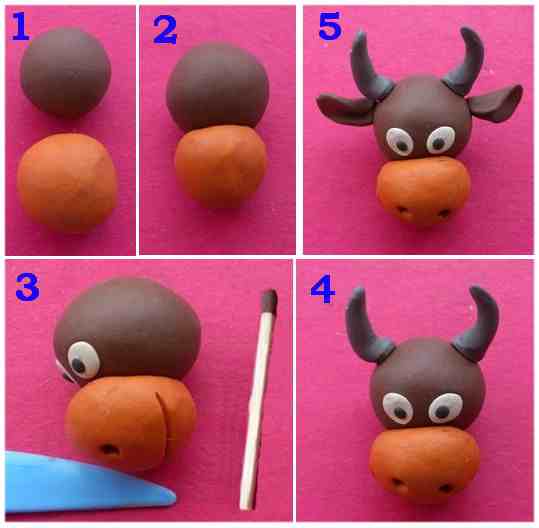
6. Pull out another large brown piece into an oval. 7. Press down on the body with your fingers, creating a characteristic relief. Stretch your neck.
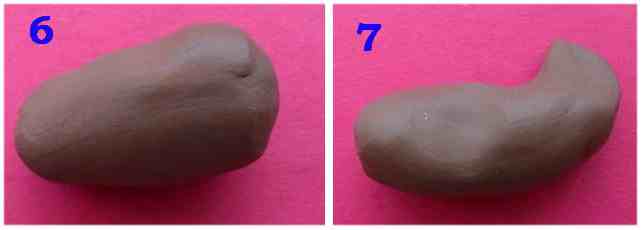
8. Simple brown sticks will replace the animal’s legs, but it is advisable to disguise matches or toothpicks inside to make the finished product more stable. This is especially true if you use soft plasticine; such a mass is unlikely to support a rather massive body. 9. Attach gray hooves to the ends of the legs.
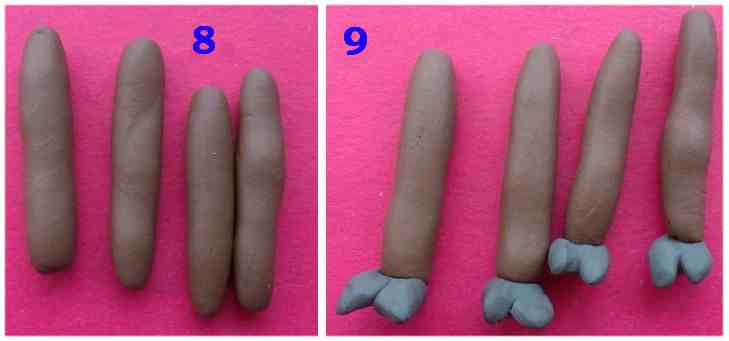
10. Attach the legs to the body and smooth out the plasticine with your fingers. 11. Make a cow’s udder from beige plasticine, because it is this detail that distinguishes a cow from a bull.
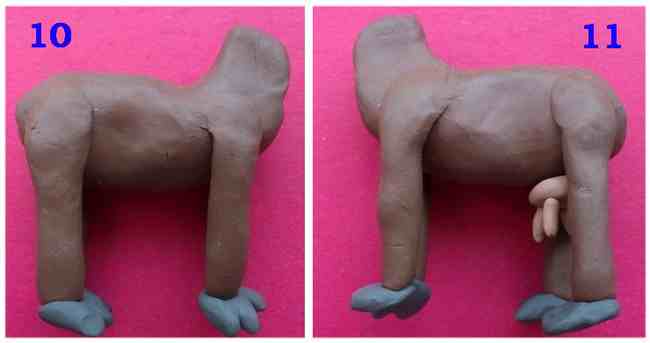
12. Pull a piece of brown plasticine into a thin long tail. Attach a beige tassel to the end. 13. Connect the head to the body. 14. The plasticine cow is ready.
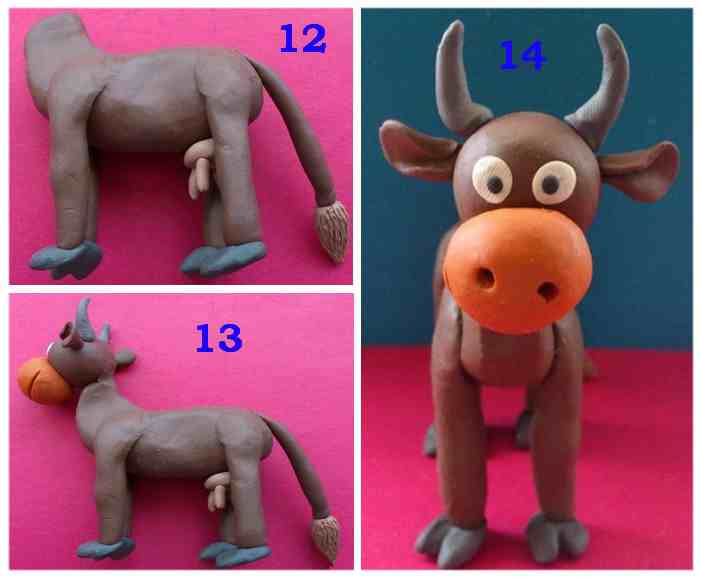
How to make a cool cow
To sculpt this cow we will use white and black plasticine, as well as a little yellow and purple.
We will need the following preparations:
1. First, twist a ball from a third of the white plasticine - this will be the head. Then we will smoke a small ball of yellow, this will be our horns. 2. Then we will twist three small black balls; these will be the ears and bangs on the forehead. 3. Next, twist the balls for the eyes: two white and two small black, as well as a purple one. 4. Now we will twist the remaining white plasticine into a ball for the body. And three small black balls for spots on the body. 5. Now take more white plasticine and roll 4 identical balls for the legs. And 4 small black ones for the cow's hooves.
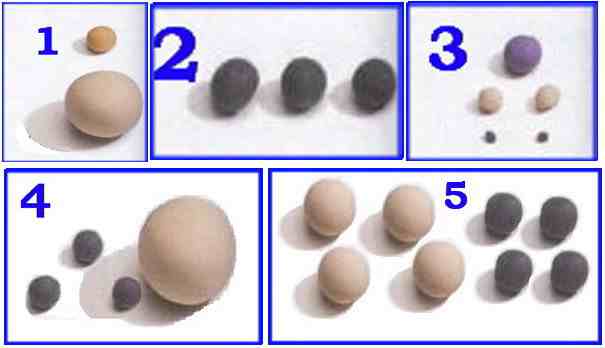
Now let's start connecting the parts:
1. First, let's make the head: take a ball for the head and make a pear-shaped figure out of it as shown in the picture. Then roll a sausage, narrowed at the ends from a yellow ball, then bend it as shown in the figure and attach it to the head. Then make nostrils by pressing them with a match.
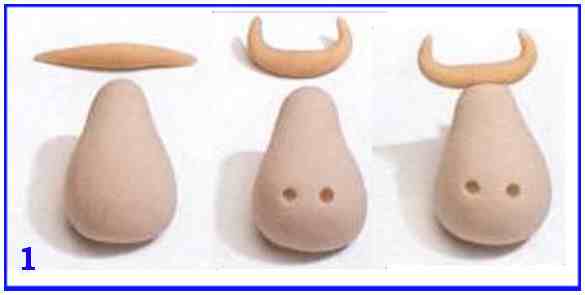
2. Next we proceed to the ears and bangs. Roll three black balls into sausages, tapered to one side. We crush them with our fingers, you should get droplets. Cut out one droplet as shown in the picture. And we do everything to the head of our cow: the ears are behind the horns, and the bangs are on the horns.
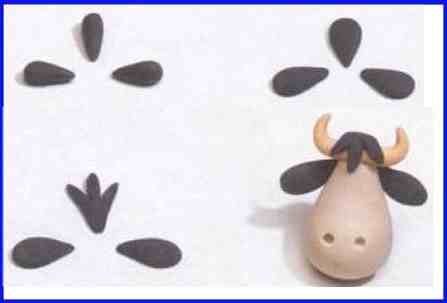
3. We move on to sculpting eyes from plasticine: roll up a sausage from purple plasticine and press it with your finger. Then we glue the eyes onto it, first white and then black. And we glue this entire structure onto the head. Our cow's head is ready.
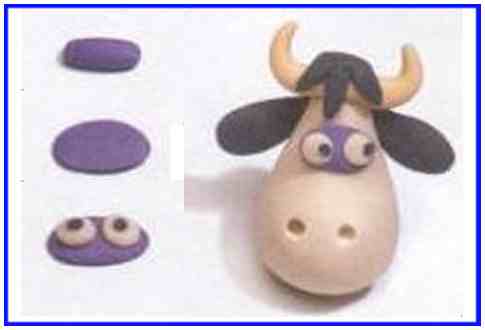
4. Let's move on to sculpting the body. From a large white ball for the body we make a pear as in the picture. And from three small black balls we make cakes and glue them on the body, in any place where you like. Next, we’ll stick toothpicks into the body so that they stick out a little and we’ll put the head on them.
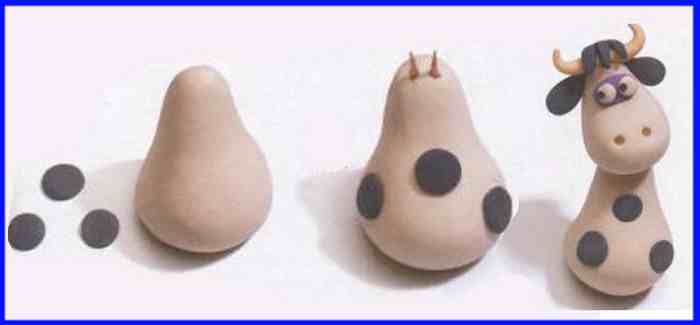
5. From the last preparations we make sausages. We bend the white ones, you can do it like in the picture, or you can figure out how your cool cow will sit. We cut the black sausages and glue them to the white ones. And then we attach the plasticine legs to the body, all that remains is to draw the mouth and our cool cow is ready! You can add a red tongue.
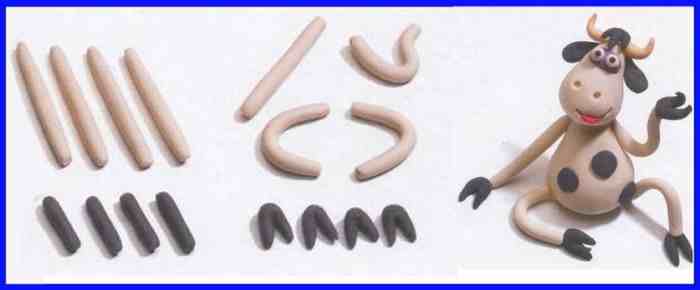
Plasticine cow, or how to mold a cow
1. Fashion figures from plasticine as shown in the figure. 2. Then assemble the figures: stick horns, ears, eyes to the head. Then attach the legs, tail, and head to the body. 3. Make black spots on the cow using black cakes. 4. And draw the hooves, muzzle, mouth, pierce the nostrils. 5. Our cow is ready!
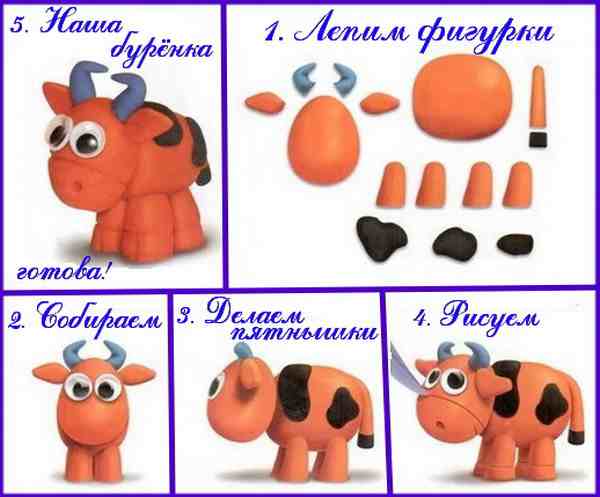
How to make a caterpillar from plasticine step by step:
1. Although the list of materials indicates green plasticine, which is more suitable for sculpting an insect, you can replace it with a different color. If you wish, combine balls of different shades and sizes to get a rainbow craft. To begin, knead the prepared block in your hands.

2. Next, use a stack to divide the soft plasticine into pieces. Make links that will make up the long body of the wriggling insect, as well as one larger piece that will become the head. Divide the green block into the required portions and knead each of them separately in your hands.

3. You can form a ball from each small piece as a link to the caterpillar’s body. Or give each ball an almond shape. A craft consisting of oval fragments will be more interesting. Glue a beige cake onto a large ball intended for the head, smooth out the edges. Then use your fingertips to give the workpiece a triangular shape.

4. Make a funny face on the beige field. Use a large pink bead to simulate a nose. Glue small black dots-eyes above the nose, and under it - a small red dot-mouth. Make two long orange tendrils. Curl and glue to the head. You can also decorate the caterpillar with a red bow.

5. Assemble the body from oval green blanks, securing the parts in random order. Glue the head on one side. This funny figure is made using the simplest method; sculpting a caterpillar is very exciting for children.
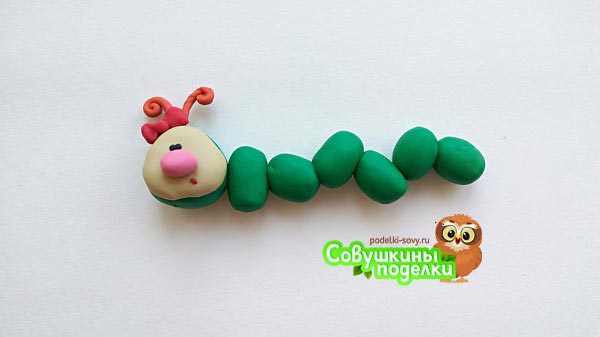
6. Use beige dots to make link decorations. This is also a way to explore numbers with young children. It is not forbidden to glue a different number of dots onto each link and then count them together. Plant the finished caterpillar in a flowering meadow. The craft is ready.
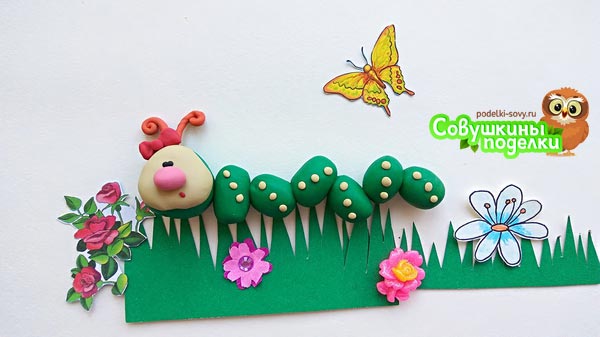
How to make a frog from plasticine
Plasticine is an amazing material that allows you to develop not only creativity and imagination, but also fine motor skills. You can make a frog from plasticine using a master class, where everything is described step by step and is understandable even for children. Follow the instructions exactly or apply your own ideas - everyone decides for themselves.
A simple do-it-yourself plasticine frog
Any child can make a frog from plasticine with their own hands in the simplest way. Just 8 main parts, 5 additional ones and the little toad will be ready. The child can complete large parts independently, and one of the adults will help him with small ones.
Sculpting process:
- Roll 2 balls from the green material - one larger than the other. Connect them together - this will be the torso and head.
- Make two identical small balls and attach them to the top of the head. Thin white plasticine circles are glued on top of them. Pupils of blue or another color are sculpted on them.
- The mouth and nose are cut using stacks or toothpicks. Attach a tongue made of red plasticine.
- Roll out two green bars. Flatten on one side, giving the shape of fins. The legs are bent and fixed on the frog's body.
- For the front legs, the blanks are made thinner and shorter. The lower part is made flattened. Cut out 3 toes on each foot, making membranes using a toothpick. Attach the legs to the body.
Frog princess made of plasticine
To get your child interested in modeling, you can make a frog princess from plasticine. To do this, first make the frog itself and add just a couple of additional details - a crown and an arrow:
- Roll the green mass into a roll and cut it into 3 pieces - 1 small and 2 larger.
- Prepare a blank for the head. One of the large pieces is rolled and flattened, giving it an oval shape.
- Roll the second large piece into a ball. Stick a toothpick or match into it and connect it to the head blank.
- From the last piece, four sausage-shaped legs are created. Bend them in half and connect them to the base.
- 2 small flat cakes are connected to the paws. 2 slightly larger cakes are attached to the body in the abdominal area.
- Make 2 balls from the remaining piece and attach them to the top of the head.
- On the base for the eyes, fix 2 white circles and stick black pupils on them.
- A stack is used to cut through the frog's mouth. Roll small balls from pale green plasticine. Slightly flattening them, place them on the head and body. The same details indicate the nostrils of a frog.
- The abdomen is made from light green material and attached to the body.
- Using the stacks, cut fingers at the edges of the foot cakes. White mini-highlights are placed on the pupils.
- To make a crown for the princess, you will need yellow or light orange plasticine. Make a sausage and roll it into thin strips. Sharp teeth cut along the edge of the stack.
- Cut a part from the jagged strip so that it has 5 teeth. They fold it into a crown, which is placed on the frog's head. The sharp ends are slightly twisted in different directions.
- A small tongue is created from a piece of red plasticine and glued to the line of the mouth.
- The arrow is molded from plasticine in brown, yellow and white colors.
Frog made of light plasticine
Making a frog from light plasticine is easy step by step. For example, you can create the heroine of the cartoon “Frog Traveler”. Parts made of this material hold their shape well, and the mass does not stick to your hands.
Important! This material is afraid of moisture, both during the work process and in finished crafts.
- Take a small piece of green mass. They give it the shape of a head with chubby cheeks. Particular attention is paid to the mouth - making it slightly pointed. Designate slightly raised areas for the eyes.
- Roll out yellow plasticine and frame the lower part of the head. A thin strip marks the opening of the mouth.
- The eyes are made from the white mass. To make them look funny and cheerful, the pupils are sculpted in different shapes, blue with black splashes.
- To save material, you can use foil for the frog’s body, which is crumpled into a pear-shaped shape and covered with a thin layer of green mass. To highlight the frog's abdomen, the front part is covered with a yellow mass.
- The bases for the frog's legs are made in the form of rounded blocks of the required size.
- The fingers and toes of the frog are squeezed out with a stack. Give them the necessary bends. Add a yellow mass to the middle of the palms.
- Connect all the parts together. For a strong attachment, the head is “set” on a match or toothpick.
- Smooth out roughness and unevenness. Add dark green splashes to the arms and legs of the frog.
Craft with a frog made of plasticine
To captivate your child, you can make together with him not only one frog from plasticine, but an entire craft. A step-by-step analysis will help you understand how to sculpt reeds using toothpicks. How to make a pond and a water lily leaf on it:
- To create a reed, you will need toothpicks, brown and green plasticine. The bottom is wrapped in green plasticine, the top in brown. Leaves are sculpted separately. Everything is connected and fixed to the surface.
- To make a water lily leaf, roll out the green mass and flatten it into an oval with your fingers. Using a stack or a knife, draw veins and make a cut in the bottom of the sheet.

- Cut out a circle or any shape large enough from cardboard to accommodate the wah and additional accessories.
- The cardboard is coated with a thin green layer.
- On top of the green layer, pieces of blue and light blue material are laid out and smeared in a chaotic manner.
- Reeds are placed at the edges.
- A water lily leaf is placed a little away from the center, on which the main character is planted.
Modeling in older preschool age
In the 6th year of life, big changes occur with the child. The proportions of the body change, the child becomes mobile, dexterous, movements are confident, and coordination improves. By this age, the small muscles of the arm are actively developing. This important ability of the hand is associated with the development of speech and thinking. In 6-year-olds, visual acuity increases significantly, and they notice small details, this is expressed in examining insects, the structure of a flower, the design of various mechanisms, etc.
Thinking at this age is concrete, and only by the age of 7 do elementary concepts appear. Naturally, all this does not happen in the same way for all children, even for those growing up in similar conditions. Speech is actively developing, the vocabulary of a 7-year-old child is about 4000 words, but children often understand figurative speech literally. Children aged 6-7 years want to learn, their cognitive interests are activated, personal communication and their own aesthetic judgments and evaluations appear in relationships with adults. In the visual activities of older preschoolers, creativity plays an increasingly important role. This is related to the development of the child's personality. Understanding this, the teacher tries to organize children's activities so that they see all the colors of life, its amazing manifestations, learn to love beauty, so that they have a special vision of the world and want to express their feelings and thoughts in creativity. The teacher should think through his classes in such a way that the training develops the child’s personality, and does not turn into training in fine skills. Therefore, the main task is to form a creative mindset, develop imagination, and emotional sensitivity in older preschoolers, i.e. development of their personality through artistic activity. Modeling classes provide all the opportunities for this. One of the most important tasks is to teach children to observe and reflect on what they see. Art teaches children high morality, so the teacher organizes the cultural environment in which children are raised so that they can get acquainted with works of art, and, if possible, visit a museum where there are sculptures, see and examine city sculpture. A more complete perception of sculpture is facilitated by the use of music, poetry, and artistic expression.
In the senior and preparatory groups for school, the teacher sets his task to teach children to sculpt using a sculptural method - pulling out parts from a whole piece, or using a ribbon method - in decorative modeling. Children must master many techniques for processing and decorating a sculpted product - be able to smooth its surface, firmly fasten parts, make moldings, recesses, reliefs, be able to use frames, use stacks, work with a variety of plastic materials, and be able to convey movement.
In older preschool age, children master modeling from imagination, from life, from memory. In terms of content, modeling can be subject, subject, or decorative. Children are able to give an aesthetic assessment to stucco images.
If in the middle group children have mastered simple form-building movements and methods of representation, then in the older group they will independently and freely operate with them, and this is the basis for creating an expressive image. The sculpting technique becomes more complicated. Children are introduced to the sculptural method of representation.
Children of primary preschool age sculpt in a constructive way, composing a whole from individual parts; it is clearer and more accessible to them, because they do not yet have a holistic perception. But the constructive method makes it difficult to maintain the correct proportions; most often, too large limbs are attached to the small body of the animal. Modeling by stretching allows the child to feel the entire mass of the animal’s body and the proportionality of the limbs. Movement with this method of sculpting is also conveyed more naturally. To more accurately convey details, it is useful to use photographs of animals in different poses or small sculptures. They provide all the necessary information about the animal and do not impose someone else’s style of depiction on it.
When introducing children to a new method of modeling, the teacher gives them a sample, which he examines and analyzes together with the children. The sample is then removed. After this, you need to show a new way of sculpting. The teacher demonstrates techniques, constantly referring to the children’s experience: “How are we going to sculpt a bird-whistle from a whole piece of clay? What should we sculpt first? How will we pull the whistle? What fingers will we use?” Children show movements with their fingers, and the teacher only corrects them. Mastering this technique is very important for developing the necessary skills in modeling, so the teacher repeats all the movements with his fingers so that all children can see them. At the next lesson, he invites the children to sculpt a Christmas tree, but not in the same way as they sculpted in the middle group, when there were no branches visible. The children have already sculpted a stump, divided it up, divided it into plasticine and rolled it into balls, from which tiers of branches will be fashioned. The teacher puts one of the balls on his finger and asks: “How to pull branches out of it?” We need to give children the opportunity to think for themselves. Only after this the teacher shows a simple and economical method of working with two fingers - pulling towards yourself with the thumb and forefinger, when the thumb is below and the index finger is on top, then with the same fingers you need to press the end of the branch from the sides so that it is thinner. This is how all branches are stretched and rounded. The children became acquainted with this technique when fashioning a whistle; when fashioning branches, the technique is the same, but the work is more delicate. Children already know how to cut fringe into stacks, imitating needles, but now they do it not around the circumference of the ball, but on each branch separately. You need to place one tier on top of another so that the branches of the tree are not located one under the other. It turns out a nice Christmas tree that resembles a real one.
If the teacher, without referring to the children’s previous experience, shows the technique himself, then the children will inertly copy his actions, such an activity will not develop them. Partial display has advantages over full display. If the children sculpted the Snow Maiden in a long fur coat, and then they had to sculpt a dancing girl in a long dress, then the teacher can limit himself to talking with the children about what movements are typical for dancers and what is the best way to depict them. Then children will be forced to solve visual problems on their own. Children become helpless when they are “led”, not allowing them to deal with technical difficulties on their own. It is enough to show children once how to smooth the surface of a sculpted figure and demonstrate the result (smooth, shiny, beautiful) to make them want to do the same. Later, during analysis, you need to praise the children who did it correctly. When showing children the technique of smoothing a surface, you should do it with the index finger, and not the thumb, since it is better to train the index finger.
V.A. Sukhomlinsky believed that the student’s mind is at the tips of his fingers, so they need to be taught to do delicate work. To do this, you can invite children to fashion a bunch of grapes or a basket of raspberries. A grape leaf is cut out of a thin disk, attached to a branch where a bunch of grapes hangs, collected from small, green balls, with riper and therefore lighter berries at the end of the cluster. This task is useful for developing arm muscles. Raspberries are molded in the same way: small balls are stuck around a large one, and green sepals are attached in one place. This is a collective work - some children make a basket, others make raspberries.
Children show their preferences in modeling in different ways; some like large forms, others like small, miniature ones. Miniature lovers can be given tasks to sculpt a rhinoceros beetle, hedgehog, or frog, providing them with photographs to clarify the details. The expressive capabilities of plasticine allow you to convey the smallest details.
Children need to be introduced to a large, generalized form in modeling, where there are no details, but the proportion and plasticity of the form are clearly visible. The most suitable material for this is snow. You just need to show your children this fascinating sculpture. It can be pure white, painted, or inlaid. You can invite children to imagine themselves as sculptors and each one to come up with their own monument, telling them that they are not always erected for people, sometimes for animals, such as cats, dogs, even insects. After getting acquainted with the city sculpture, children will willingly take on creating their own. They are attracted by the space for creativity.
Modeling can also be used as an element in the construction of buildings made of sand, clay, or natural materials. It’s a shame that sculpting large forms is rarely practiced in kindergarten; concentration on plasticine and small forms develops children one-sidedly. In such modeling, the teacher is a co-author and inspirer, and not a dry mentor. Children love adults who play with them.
It is interesting to try with children the technique of clay modeling with inlay and subsequent firing. Frogs, lizards, fish, inlaid with glass beads, plastic, smalt, polyethylene granules, are very decorative.
Children need to be involved in decorative modeling. It’s better to start by creating bas-reliefs, from which you can then create a frieze. A plate of ceramics or thick cardboard 15x15 cm is covered with a layer of plasticine; this is the background of the bas-relief. Then, from a thicker layer of plasticine of a contrasting color, an image is cut out in a stack and transferred to the background. Next comes finishing - sculpting parts, smearing, smoothing. The main goal of these classes is to teach children to improve their work, achieving high aesthetic quality. If the bas-relief needs to be preserved for a long time, it is covered with two layers of varnish. You can sculpt on a bas-relief the fabulous Firebird, Gena the crocodile, the Frog Princess, beautiful fish, birds, bouquets of berries, flowers, a plot from a fairy tale.
You can introduce children to the modeling of Dymkovo toys in the middle group, but it is better to start in the senior group. The teacher shows the children Dymkovo toys, admires the bright, elegant range of colors with them, and tells them where they are made. Looking at the toys, the teacher and the children determine the secret of their beauty. The toys remain in the group room and the children look at them for several days. In his free time, the teacher sits down at a table and begins to sculpt a Dymkovo toy in front of the children, accompanying his actions with the words: “Now I will roll out the clay and carefully roll a bell out of it, it will turn out to be a big, beautiful skirt. And this is how I will sculpt and attach the body to it, we will make arms from these sausages, bend them like this and put them in the muff. To make the blouse elegant, we will make a frill at the top and bottom. Now we will make a hairstyle from thin flagella, curl them beautifully, like this. Now we’ll make a beautiful hat.” Approximately like this, i.e. in detail, the teacher tells how to sculpt a lady, accompanying each of his actions with an explanation.
Having asked the children if they would like to sculpt a Dymkovo toy, the teacher prepares clay, which takes several days. Modeling a Dymkovo toy is a festive event, children should look forward to it. From all the variety of Dymkovo toys, it is better to start with a fish, it is stable, the parts are firmly attached to it and do not fall off. Everything must be done to ensure that the child’s first job is successful. Then you can make konika, lamb. They are sculpted using a combined method - the body and legs are made from one piece, cut on both sides with a stack, the head and neck are sculpted from another and affixed to the body, horns, curly bangs, ears are sculpted separately and smeared on. Separately, frills are molded onto the lamb’s legs and moldings in the form of small cakes. These decorations are typical for Dymkovo toys, and children should be introduced to how they are sculpted. The frill is molded in the shape of a sausage, it is placed on a wet cloth, covered and rubbed with a finger, turning it into a ribbon. Gather the frill from the ribbon with your fingers. A narrow frill is for a lamb’s legs, a wide one is for an apron for a nanny, for a blouse for a lady. The frill is the most difficult part in all modeling; it must be skillfully assembled with your fingers directly on the product and immediately applied.
The difficulty in sculpting a Dymkovo toy is that children sculpt slowly, but the clay dries quickly and the parts fall off. Therefore, the first works should be simple in shape, stable, for example, a fish, a whistle, a turkey. These toys do not have legs that bend or hold up, so they are easy to sculpt. After drying, firing and whitewashing, children begin painting toys. First, you need to invite the children to look at how the toys are painted, talk about the traditions in painting, then make sketches on paper and practice.
Whitewash for Dymkovo toys is made from milk in which chalk is mixed (to test, dip your finger into the whitewash, if the whitewash does not drain from it, then the consistency is good), you can also use water-based paint. The toys are whitened with a brush in two layers. Paints are made like this: an egg is broken on top and the white is poured out of it, the yolk remaining in the shell is poured with vinegar, mixed and poured into a cup, vinegar is poured into the shell a second time and poured into the same cup, everything is mixed. The result was an emulsion for diluting paint. This paint is called egg tempera. It does not fade, does not fade, and lays down very firmly. You can replace this paint with gouache, to which a little PVA glue has been added. Dymkovo craftswomen paint their toys with squirrel brushes, and dots and small circles with stamps made from evenly cut round sticks.
When working on a Dymkovo toy, you cannot replace material, such as clay with plasticine: traditions are violated and bad taste is fostered. Plasticine is more elastic than clay, it allows you to sculpt the main volumes and details more finely and thinly, and this is unusual for a Dymkovo toy. Clay produces denser, rounded shapes, traditional for haze.
When working with older preschoolers, the teacher more often than with younger ones uses productive methods - heuristic and research. It is very important that at this age children acquire the necessary learning skills, including practical and intellectual activities. One of them is the ability to read a diagram. During a modeling lesson, the teacher invites children to learn how to sculpt a person in motion, so that his figure is stable and his pose can be changed. The teacher shows the children a block of plasticine and a diagram of its cutting, where the head, arms and legs are sculpted from a whole piece. Together with the children, he disassembles the diagram, asking them questions: “This picture shows a piece of plasticine from which we must fashion a person, but not in the usual way, putting the head, arms and legs to the body, but from a whole piece, pinching it somewhere , and somewhere cutting. Where will our head be? How do we highlight it? (you need to pinch the block in the place where the neck should be; this is shown by arrows on both sides of the block).
How do we select the legs?
What are we asked to do in the diagram? (Cut the block from the bottom.)
How do we select the arms?
How is this shown in the diagram? (Make 2 slanting cuts below the head.)
How long should the cuts be?” Having analyzed the diagram with the children, the teacher cuts his block in the right places and asks the children what needs to be done to make the arms and legs round? On his block he shows how to round and highlight the foot on the leg. Then he asks the children how to depict the movement of their legs (bending them at the knees), how to make the figure stable, how to bend their arms so that they do not look like sticks. When the figure becomes stable, he invites each of the children to sculpt their own image - a mushroom picker with a basket, or a skier, or a hockey player. During the analysis, the teacher notes those figures in which movement is more expressively conveyed.
Children can figure out the following diagram on their own. The theme is familiar - “Horse”. In the middle group, they sculpted a horse from two pieces - from one - the body and legs, from the other - the head and neck. A cat and a dog were sculpted in a similar way. Now another way of sculpting a horse is proposed: from one large piece - the head, neck and torso, and from another - four legs and a tail. The diagram shows how to divide the plasticine, how to bend it, and shows the finished horse. The teacher reminds the children that a horse can be standing, galloping, dancing - with its front leg raised. Thus, during modeling classes, the teacher develops constructive abilities in children. During the analysis, he notes the expressiveness of the horse's pose and aesthetic design - neatness in sculpting details, smoothness of the surface, additional decorations - a saddle, etc. It is necessary to involve children in the analysis.
In older preschool age, motives for activity change; play motives give way to cognitive ones. Taking this into account, the teacher invites children to create a panorama about the life of elephants, or crocodiles, or dinosaurs in their free time. Illustrations in books are used for clarity. The teacher warns that the figures are voluminous, and plasticine should be used sparingly, and asks the children how this can be done. It is important that children figure out how to sculpt animals on frames themselves. These can be oval-shaped inserts, eggshells, bottles. The work of making a panorama is a collective one. Its value lies in the fact that children learn to jointly solve problems and carry them out, take other people’s opinions into account, and adopt the experience of plastic activities. When making a panorama, each child needs to find something they can do, but everyone must be a participant. Complex tasks such as making a panorama are needed for older preschoolers. They learn to adjust their activities depending on the difficulties encountered, make unconventional decisions, plan their activities and evaluate their results in accordance with the assigned tasks.
Plastic activity comprehensively develops the personality of preschoolers if there is no routine in it, if the teacher constantly relies on the experience of children and uses developmental methods, if aesthetic feelings are formed in children during the lesson. Every child should feel the joy of creativity in these classes.
